Dragon Multinationals: New Players in 21st-Century Globalization
VerifiedAdded on 2023/05/28
|33
|9989
|213
AI Summary
This report discusses the impact of globalization on the global business, with a focus on Dragon Multinationals - the new players in globalization. It analyzes the challenges and opportunities for multinational corporations, and identifies strategies needed by old and new players in the 21st century.
Contribute Materials
Your contribution can guide someone’s learning journey. Share your
documents today.
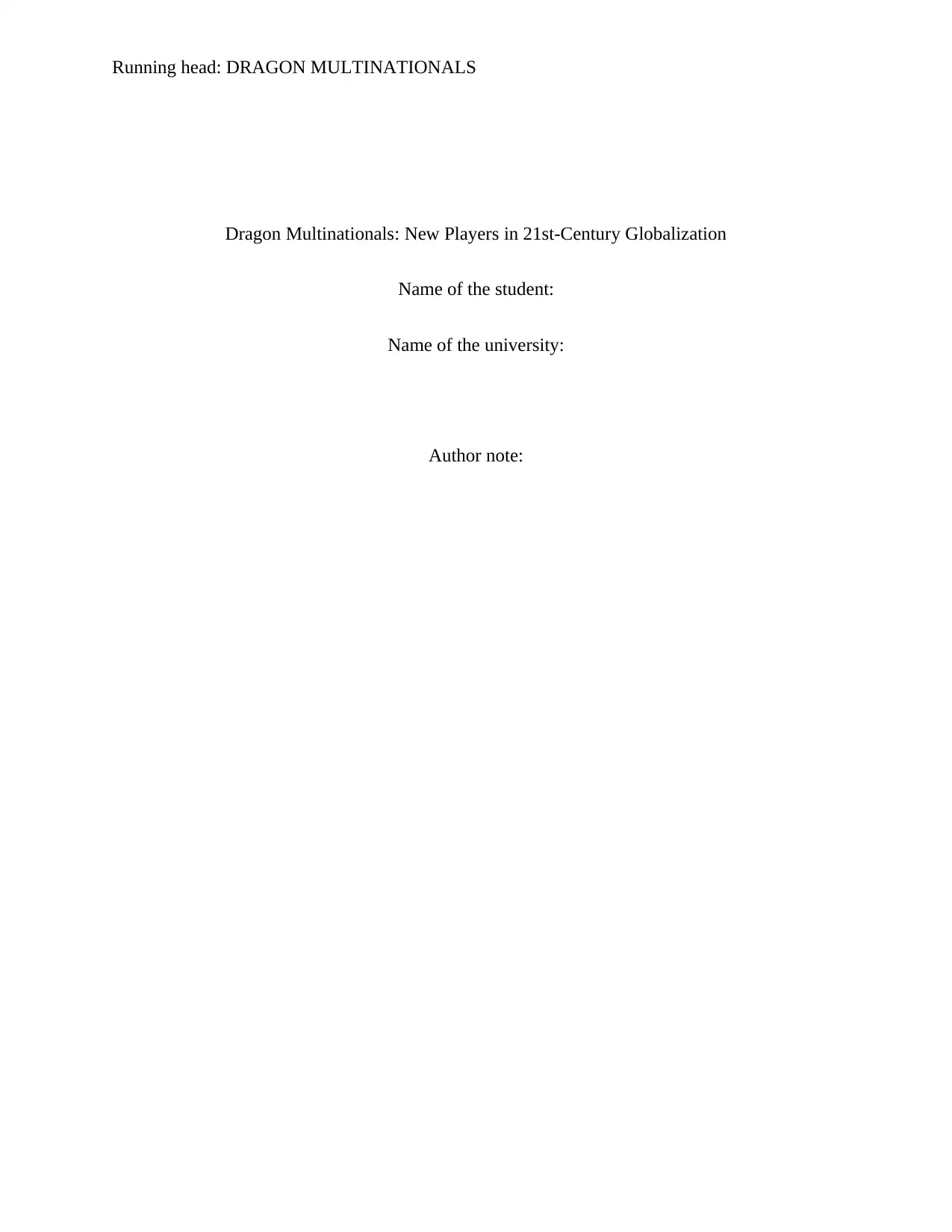
Running head: DRAGON MULTINATIONALS
Dragon Multinationals: New Players in 21st-Century Globalization
Name of the student:
Name of the university:
Author note:
Dragon Multinationals: New Players in 21st-Century Globalization
Name of the student:
Name of the university:
Author note:
Secure Best Marks with AI Grader
Need help grading? Try our AI Grader for instant feedback on your assignments.
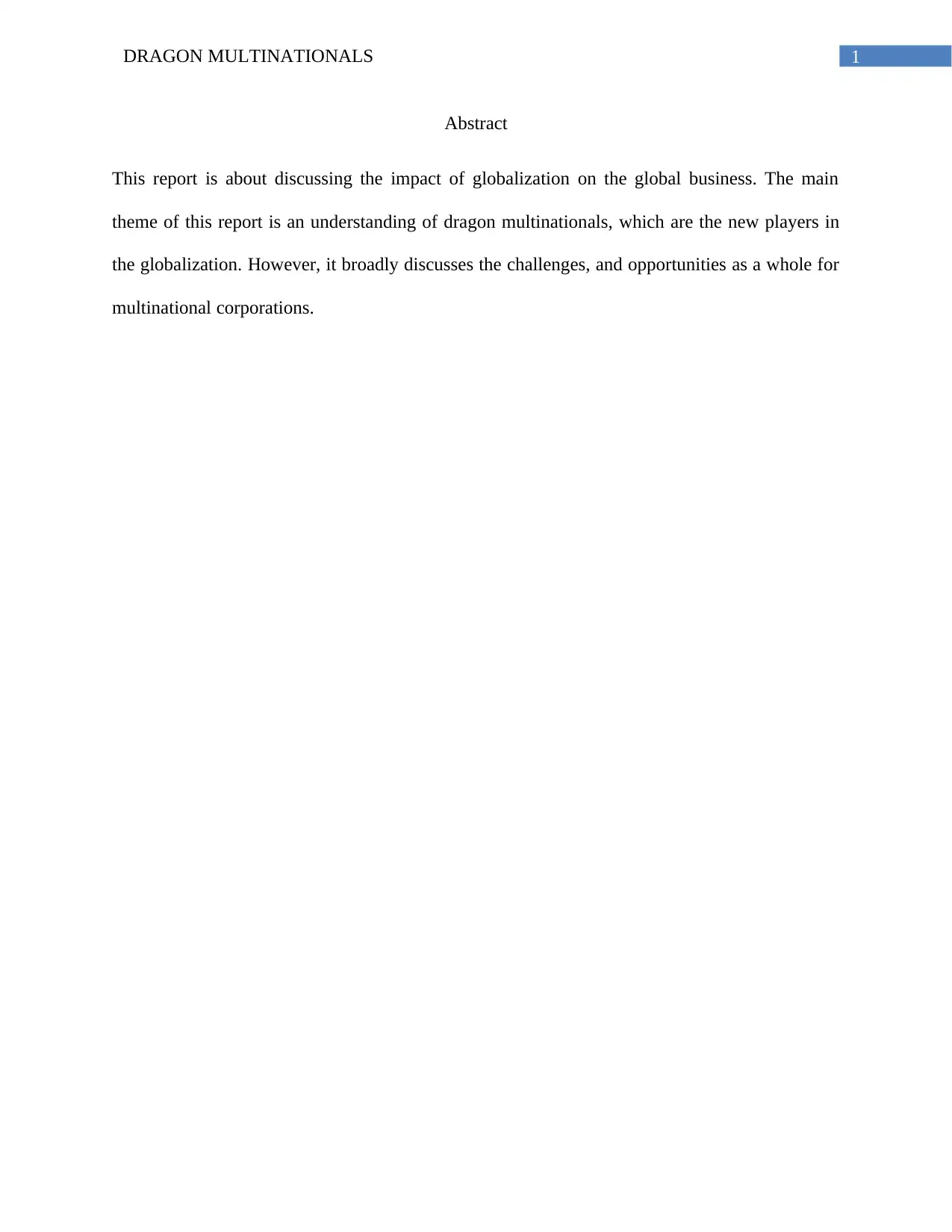
1DRAGON MULTINATIONALS
Abstract
This report is about discussing the impact of globalization on the global business. The main
theme of this report is an understanding of dragon multinationals, which are the new players in
the globalization. However, it broadly discusses the challenges, and opportunities as a whole for
multinational corporations.
Abstract
This report is about discussing the impact of globalization on the global business. The main
theme of this report is an understanding of dragon multinationals, which are the new players in
the globalization. However, it broadly discusses the challenges, and opportunities as a whole for
multinational corporations.
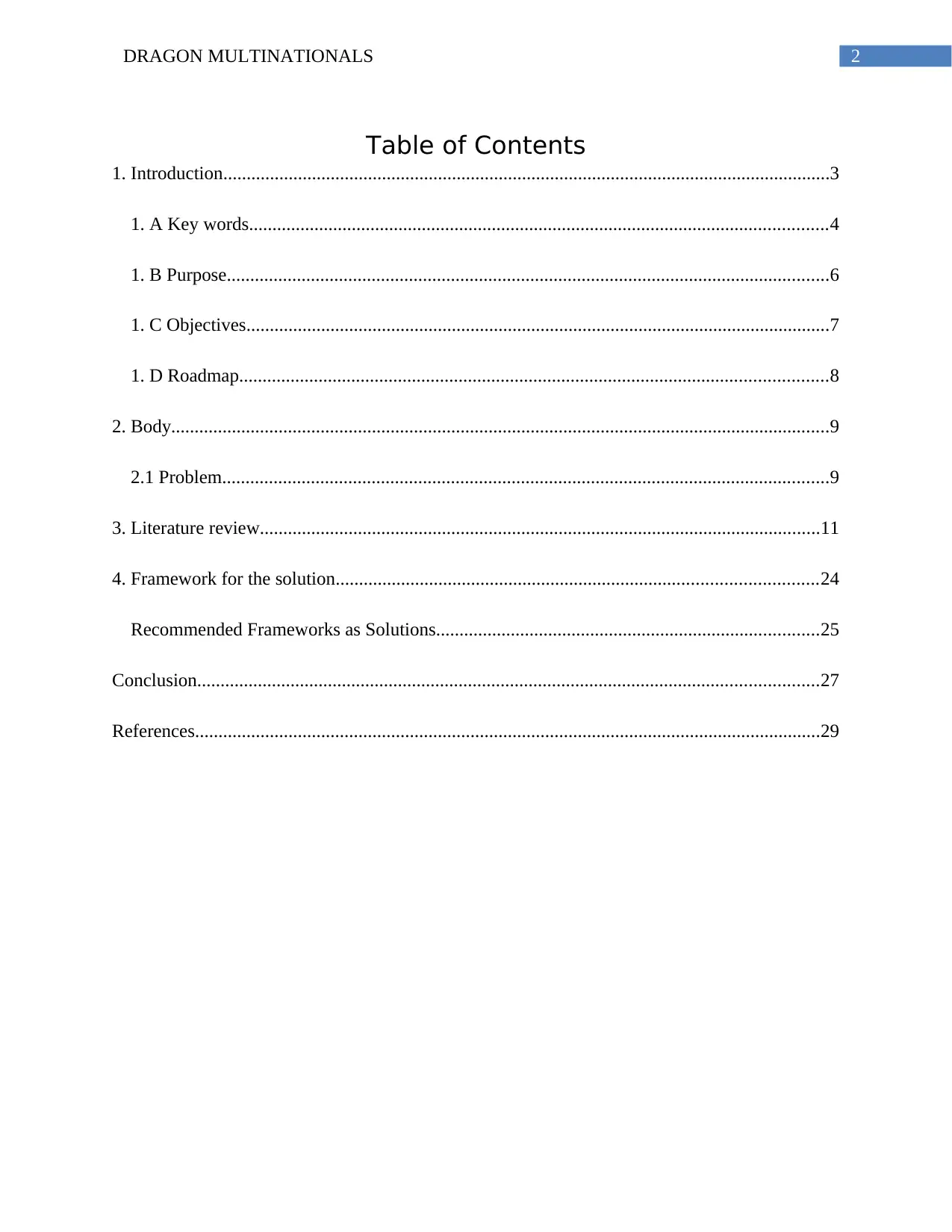
2DRAGON MULTINATIONALS
Table of Contents
1. Introduction..................................................................................................................................3
1. A Key words............................................................................................................................4
1. B Purpose.................................................................................................................................6
1. C Objectives.............................................................................................................................7
1. D Roadmap..............................................................................................................................8
2. Body.............................................................................................................................................9
2.1 Problem..................................................................................................................................9
3. Literature review........................................................................................................................11
4. Framework for the solution.......................................................................................................24
Recommended Frameworks as Solutions..................................................................................25
Conclusion.....................................................................................................................................27
References......................................................................................................................................29
Table of Contents
1. Introduction..................................................................................................................................3
1. A Key words............................................................................................................................4
1. B Purpose.................................................................................................................................6
1. C Objectives.............................................................................................................................7
1. D Roadmap..............................................................................................................................8
2. Body.............................................................................................................................................9
2.1 Problem..................................................................................................................................9
3. Literature review........................................................................................................................11
4. Framework for the solution.......................................................................................................24
Recommended Frameworks as Solutions..................................................................................25
Conclusion.....................................................................................................................................27
References......................................................................................................................................29
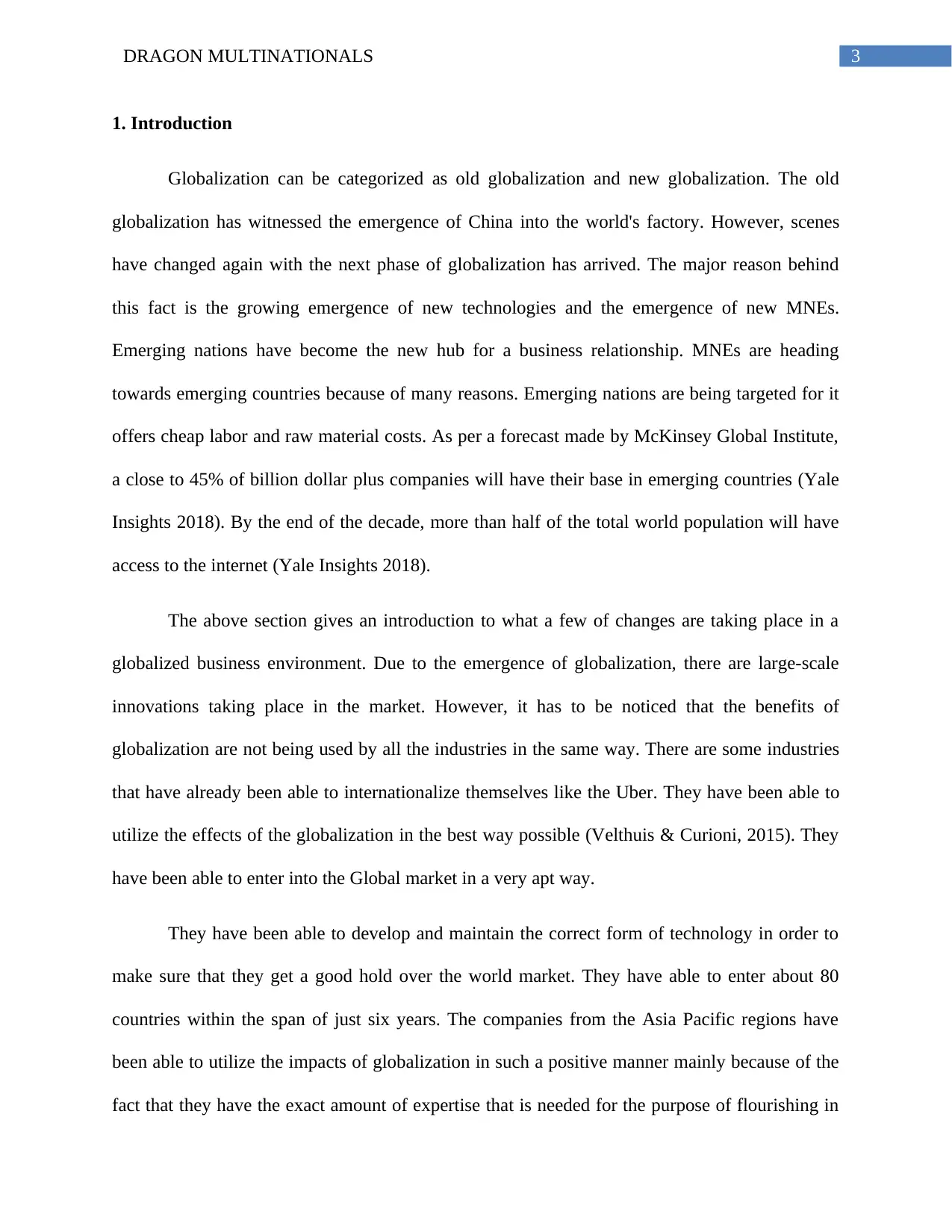
3DRAGON MULTINATIONALS
1. Introduction
Globalization can be categorized as old globalization and new globalization. The old
globalization has witnessed the emergence of China into the world's factory. However, scenes
have changed again with the next phase of globalization has arrived. The major reason behind
this fact is the growing emergence of new technologies and the emergence of new MNEs.
Emerging nations have become the new hub for a business relationship. MNEs are heading
towards emerging countries because of many reasons. Emerging nations are being targeted for it
offers cheap labor and raw material costs. As per a forecast made by McKinsey Global Institute,
a close to 45% of billion dollar plus companies will have their base in emerging countries (Yale
Insights 2018). By the end of the decade, more than half of the total world population will have
access to the internet (Yale Insights 2018).
The above section gives an introduction to what a few of changes are taking place in a
globalized business environment. Due to the emergence of globalization, there are large-scale
innovations taking place in the market. However, it has to be noticed that the benefits of
globalization are not being used by all the industries in the same way. There are some industries
that have already been able to internationalize themselves like the Uber. They have been able to
utilize the effects of the globalization in the best way possible (Velthuis & Curioni, 2015). They
have been able to enter into the Global market in a very apt way.
They have been able to develop and maintain the correct form of technology in order to
make sure that they get a good hold over the world market. They have able to enter about 80
countries within the span of just six years. The companies from the Asia Pacific regions have
been able to utilize the impacts of globalization in such a positive manner mainly because of the
fact that they have the exact amount of expertise that is needed for the purpose of flourishing in
1. Introduction
Globalization can be categorized as old globalization and new globalization. The old
globalization has witnessed the emergence of China into the world's factory. However, scenes
have changed again with the next phase of globalization has arrived. The major reason behind
this fact is the growing emergence of new technologies and the emergence of new MNEs.
Emerging nations have become the new hub for a business relationship. MNEs are heading
towards emerging countries because of many reasons. Emerging nations are being targeted for it
offers cheap labor and raw material costs. As per a forecast made by McKinsey Global Institute,
a close to 45% of billion dollar plus companies will have their base in emerging countries (Yale
Insights 2018). By the end of the decade, more than half of the total world population will have
access to the internet (Yale Insights 2018).
The above section gives an introduction to what a few of changes are taking place in a
globalized business environment. Due to the emergence of globalization, there are large-scale
innovations taking place in the market. However, it has to be noticed that the benefits of
globalization are not being used by all the industries in the same way. There are some industries
that have already been able to internationalize themselves like the Uber. They have been able to
utilize the effects of the globalization in the best way possible (Velthuis & Curioni, 2015). They
have been able to enter into the Global market in a very apt way.
They have been able to develop and maintain the correct form of technology in order to
make sure that they get a good hold over the world market. They have able to enter about 80
countries within the span of just six years. The companies from the Asia Pacific regions have
been able to utilize the impacts of globalization in such a positive manner mainly because of the
fact that they have the exact amount of expertise that is needed for the purpose of flourishing in
Secure Best Marks with AI Grader
Need help grading? Try our AI Grader for instant feedback on your assignments.
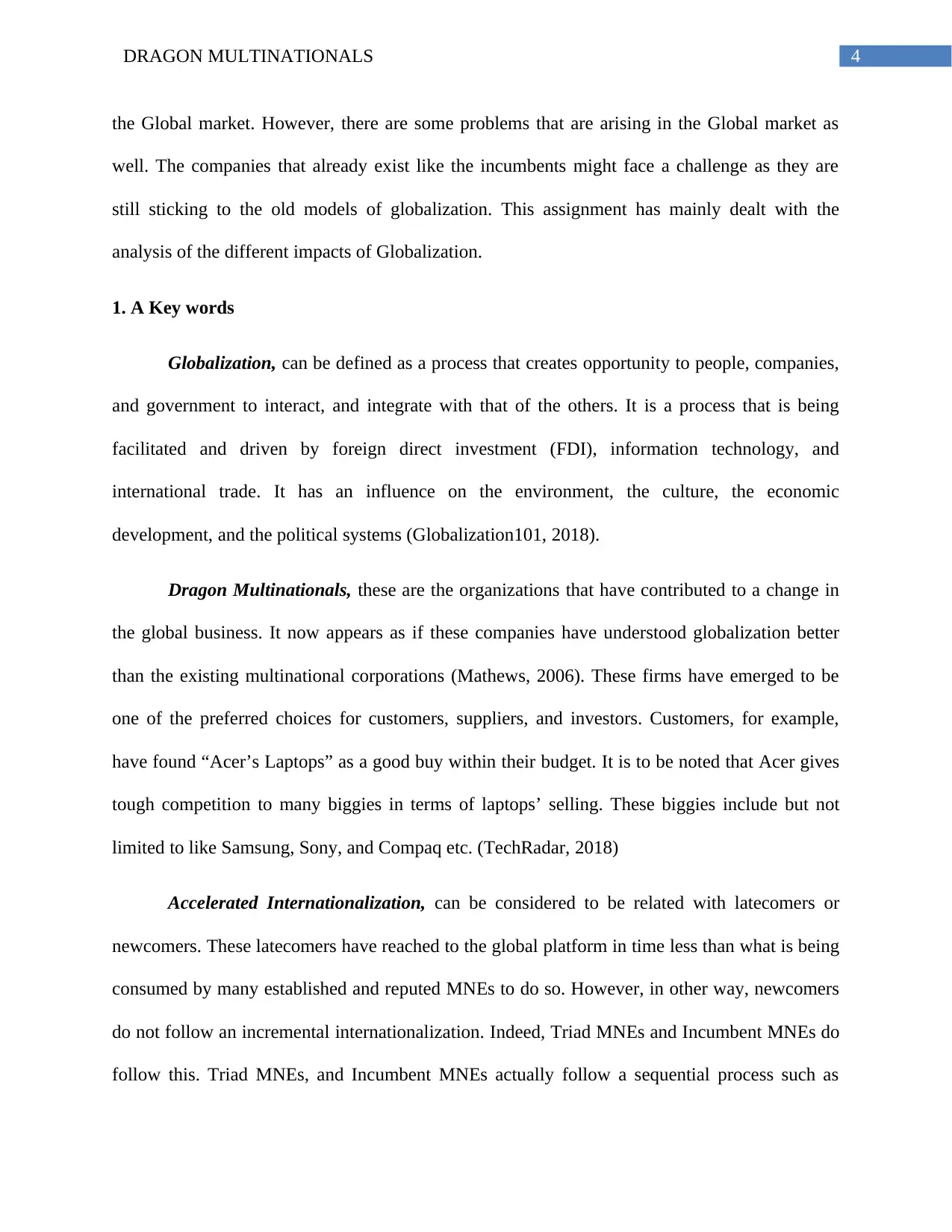
4DRAGON MULTINATIONALS
the Global market. However, there are some problems that are arising in the Global market as
well. The companies that already exist like the incumbents might face a challenge as they are
still sticking to the old models of globalization. This assignment has mainly dealt with the
analysis of the different impacts of Globalization.
1. A Key words
Globalization, can be defined as a process that creates opportunity to people, companies,
and government to interact, and integrate with that of the others. It is a process that is being
facilitated and driven by foreign direct investment (FDI), information technology, and
international trade. It has an influence on the environment, the culture, the economic
development, and the political systems (Globalization101, 2018).
Dragon Multinationals, these are the organizations that have contributed to a change in
the global business. It now appears as if these companies have understood globalization better
than the existing multinational corporations (Mathews, 2006). These firms have emerged to be
one of the preferred choices for customers, suppliers, and investors. Customers, for example,
have found “Acer’s Laptops” as a good buy within their budget. It is to be noted that Acer gives
tough competition to many biggies in terms of laptops’ selling. These biggies include but not
limited to like Samsung, Sony, and Compaq etc. (TechRadar, 2018)
Accelerated Internationalization, can be considered to be related with latecomers or
newcomers. These latecomers have reached to the global platform in time less than what is being
consumed by many established and reputed MNEs to do so. However, in other way, newcomers
do not follow an incremental internationalization. Indeed, Triad MNEs and Incumbent MNEs do
follow this. Triad MNEs, and Incumbent MNEs actually follow a sequential process such as
the Global market. However, there are some problems that are arising in the Global market as
well. The companies that already exist like the incumbents might face a challenge as they are
still sticking to the old models of globalization. This assignment has mainly dealt with the
analysis of the different impacts of Globalization.
1. A Key words
Globalization, can be defined as a process that creates opportunity to people, companies,
and government to interact, and integrate with that of the others. It is a process that is being
facilitated and driven by foreign direct investment (FDI), information technology, and
international trade. It has an influence on the environment, the culture, the economic
development, and the political systems (Globalization101, 2018).
Dragon Multinationals, these are the organizations that have contributed to a change in
the global business. It now appears as if these companies have understood globalization better
than the existing multinational corporations (Mathews, 2006). These firms have emerged to be
one of the preferred choices for customers, suppliers, and investors. Customers, for example,
have found “Acer’s Laptops” as a good buy within their budget. It is to be noted that Acer gives
tough competition to many biggies in terms of laptops’ selling. These biggies include but not
limited to like Samsung, Sony, and Compaq etc. (TechRadar, 2018)
Accelerated Internationalization, can be considered to be related with latecomers or
newcomers. These latecomers have reached to the global platform in time less than what is being
consumed by many established and reputed MNEs to do so. However, in other way, newcomers
do not follow an incremental internationalization. Indeed, Triad MNEs and Incumbent MNEs do
follow this. Triad MNEs, and Incumbent MNEs actually follow a sequential process such as
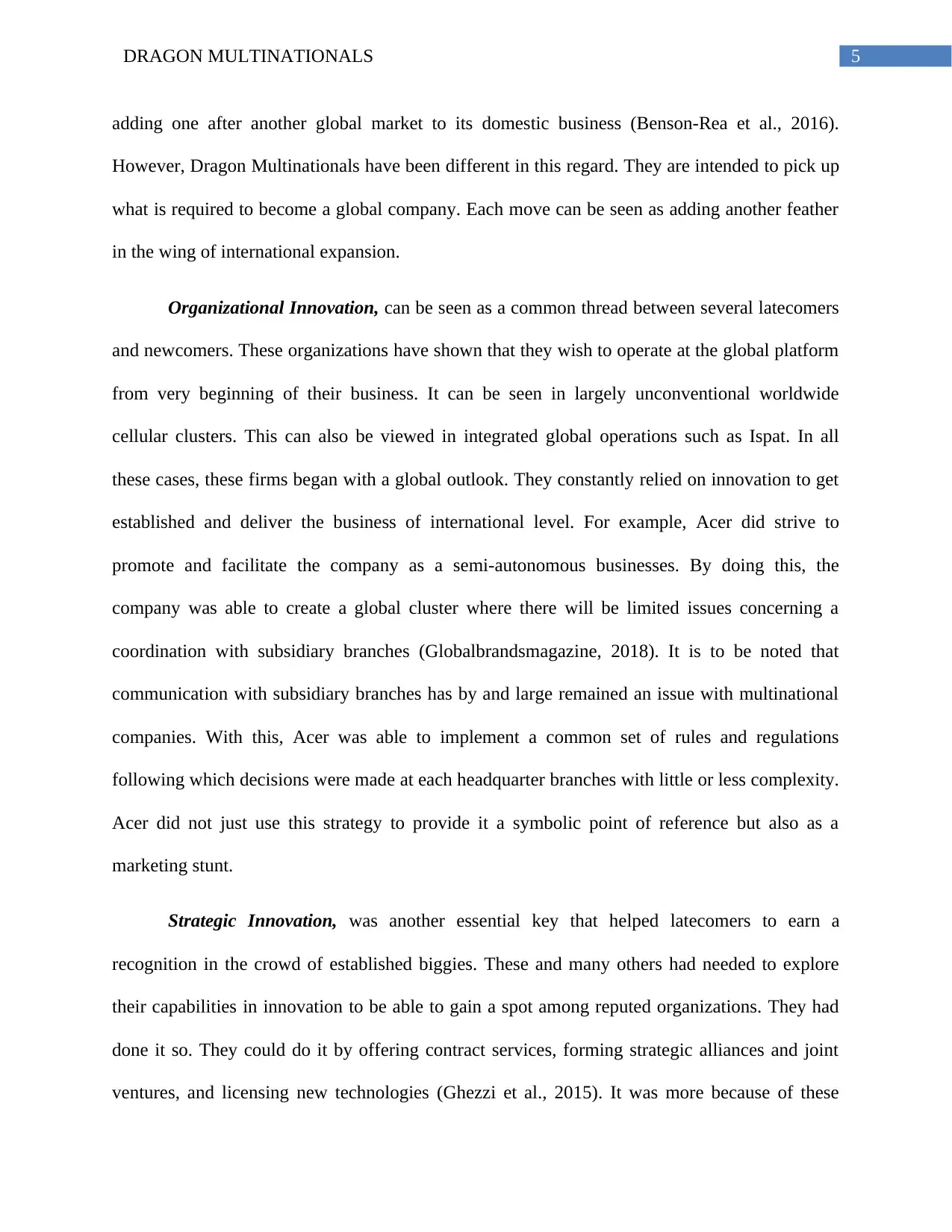
5DRAGON MULTINATIONALS
adding one after another global market to its domestic business (Benson-Rea et al., 2016).
However, Dragon Multinationals have been different in this regard. They are intended to pick up
what is required to become a global company. Each move can be seen as adding another feather
in the wing of international expansion.
Organizational Innovation, can be seen as a common thread between several latecomers
and newcomers. These organizations have shown that they wish to operate at the global platform
from very beginning of their business. It can be seen in largely unconventional worldwide
cellular clusters. This can also be viewed in integrated global operations such as Ispat. In all
these cases, these firms began with a global outlook. They constantly relied on innovation to get
established and deliver the business of international level. For example, Acer did strive to
promote and facilitate the company as a semi-autonomous businesses. By doing this, the
company was able to create a global cluster where there will be limited issues concerning a
coordination with subsidiary branches (Globalbrandsmagazine, 2018). It is to be noted that
communication with subsidiary branches has by and large remained an issue with multinational
companies. With this, Acer was able to implement a common set of rules and regulations
following which decisions were made at each headquarter branches with little or less complexity.
Acer did not just use this strategy to provide it a symbolic point of reference but also as a
marketing stunt.
Strategic Innovation, was another essential key that helped latecomers to earn a
recognition in the crowd of established biggies. These and many others had needed to explore
their capabilities in innovation to be able to gain a spot among reputed organizations. They had
done it so. They could do it by offering contract services, forming strategic alliances and joint
ventures, and licensing new technologies (Ghezzi et al., 2015). It was more because of these
adding one after another global market to its domestic business (Benson-Rea et al., 2016).
However, Dragon Multinationals have been different in this regard. They are intended to pick up
what is required to become a global company. Each move can be seen as adding another feather
in the wing of international expansion.
Organizational Innovation, can be seen as a common thread between several latecomers
and newcomers. These organizations have shown that they wish to operate at the global platform
from very beginning of their business. It can be seen in largely unconventional worldwide
cellular clusters. This can also be viewed in integrated global operations such as Ispat. In all
these cases, these firms began with a global outlook. They constantly relied on innovation to get
established and deliver the business of international level. For example, Acer did strive to
promote and facilitate the company as a semi-autonomous businesses. By doing this, the
company was able to create a global cluster where there will be limited issues concerning a
coordination with subsidiary branches (Globalbrandsmagazine, 2018). It is to be noted that
communication with subsidiary branches has by and large remained an issue with multinational
companies. With this, Acer was able to implement a common set of rules and regulations
following which decisions were made at each headquarter branches with little or less complexity.
Acer did not just use this strategy to provide it a symbolic point of reference but also as a
marketing stunt.
Strategic Innovation, was another essential key that helped latecomers to earn a
recognition in the crowd of established biggies. These and many others had needed to explore
their capabilities in innovation to be able to gain a spot among reputed organizations. They had
done it so. They could do it by offering contract services, forming strategic alliances and joint
ventures, and licensing new technologies (Ghezzi et al., 2015). It was more because of these
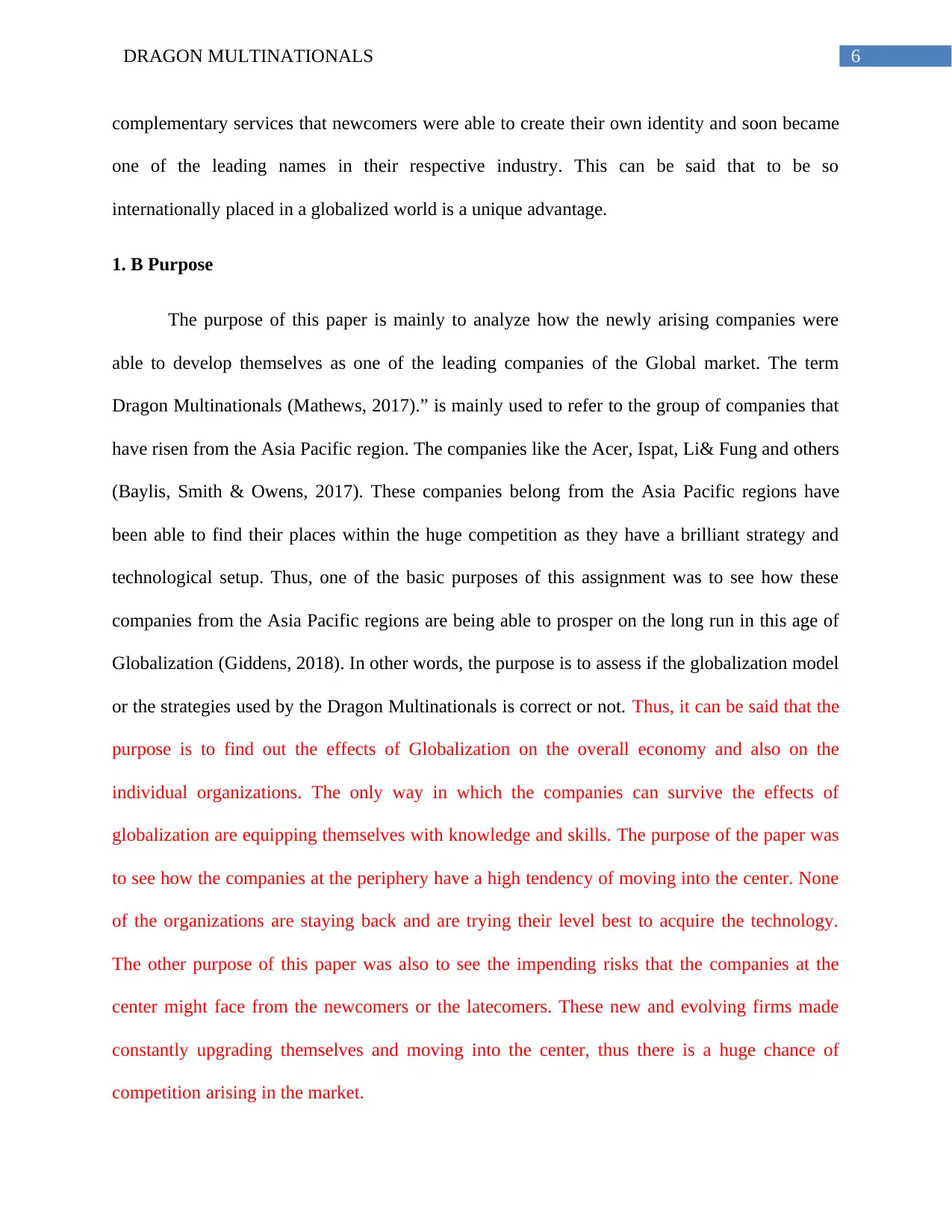
6DRAGON MULTINATIONALS
complementary services that newcomers were able to create their own identity and soon became
one of the leading names in their respective industry. This can be said that to be so
internationally placed in a globalized world is a unique advantage.
1. B Purpose
The purpose of this paper is mainly to analyze how the newly arising companies were
able to develop themselves as one of the leading companies of the Global market. The term
Dragon Multinationals (Mathews, 2017).” is mainly used to refer to the group of companies that
have risen from the Asia Pacific region. The companies like the Acer, Ispat, Li& Fung and others
(Baylis, Smith & Owens, 2017). These companies belong from the Asia Pacific regions have
been able to find their places within the huge competition as they have a brilliant strategy and
technological setup. Thus, one of the basic purposes of this assignment was to see how these
companies from the Asia Pacific regions are being able to prosper on the long run in this age of
Globalization (Giddens, 2018). In other words, the purpose is to assess if the globalization model
or the strategies used by the Dragon Multinationals is correct or not. Thus, it can be said that the
purpose is to find out the effects of Globalization on the overall economy and also on the
individual organizations. The only way in which the companies can survive the effects of
globalization are equipping themselves with knowledge and skills. The purpose of the paper was
to see how the companies at the periphery have a high tendency of moving into the center. None
of the organizations are staying back and are trying their level best to acquire the technology.
The other purpose of this paper was also to see the impending risks that the companies at the
center might face from the newcomers or the latecomers. These new and evolving firms made
constantly upgrading themselves and moving into the center, thus there is a huge chance of
competition arising in the market.
complementary services that newcomers were able to create their own identity and soon became
one of the leading names in their respective industry. This can be said that to be so
internationally placed in a globalized world is a unique advantage.
1. B Purpose
The purpose of this paper is mainly to analyze how the newly arising companies were
able to develop themselves as one of the leading companies of the Global market. The term
Dragon Multinationals (Mathews, 2017).” is mainly used to refer to the group of companies that
have risen from the Asia Pacific region. The companies like the Acer, Ispat, Li& Fung and others
(Baylis, Smith & Owens, 2017). These companies belong from the Asia Pacific regions have
been able to find their places within the huge competition as they have a brilliant strategy and
technological setup. Thus, one of the basic purposes of this assignment was to see how these
companies from the Asia Pacific regions are being able to prosper on the long run in this age of
Globalization (Giddens, 2018). In other words, the purpose is to assess if the globalization model
or the strategies used by the Dragon Multinationals is correct or not. Thus, it can be said that the
purpose is to find out the effects of Globalization on the overall economy and also on the
individual organizations. The only way in which the companies can survive the effects of
globalization are equipping themselves with knowledge and skills. The purpose of the paper was
to see how the companies at the periphery have a high tendency of moving into the center. None
of the organizations are staying back and are trying their level best to acquire the technology.
The other purpose of this paper was also to see the impending risks that the companies at the
center might face from the newcomers or the latecomers. These new and evolving firms made
constantly upgrading themselves and moving into the center, thus there is a huge chance of
competition arising in the market.
Paraphrase This Document
Need a fresh take? Get an instant paraphrase of this document with our AI Paraphraser
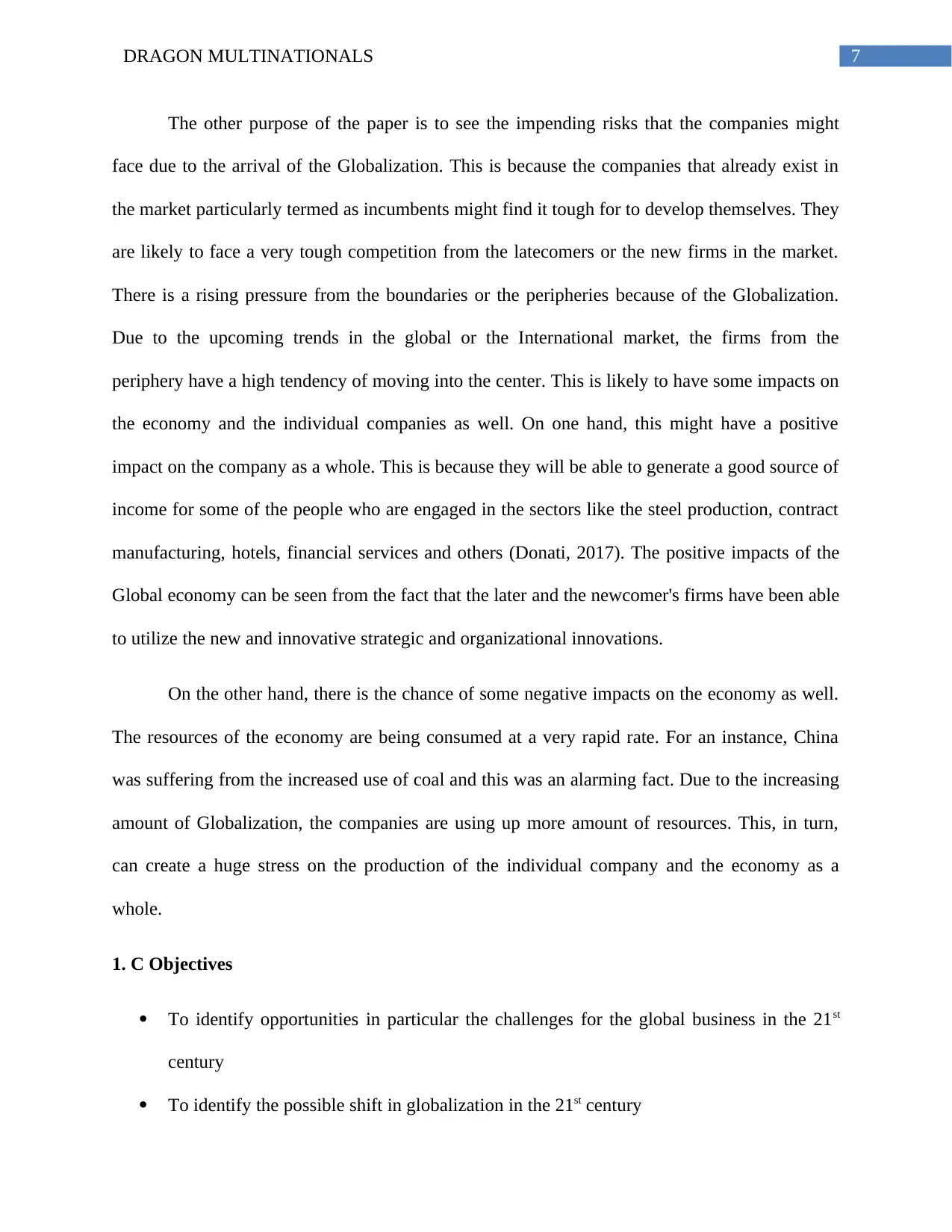
7DRAGON MULTINATIONALS
The other purpose of the paper is to see the impending risks that the companies might
face due to the arrival of the Globalization. This is because the companies that already exist in
the market particularly termed as incumbents might find it tough for to develop themselves. They
are likely to face a very tough competition from the latecomers or the new firms in the market.
There is a rising pressure from the boundaries or the peripheries because of the Globalization.
Due to the upcoming trends in the global or the International market, the firms from the
periphery have a high tendency of moving into the center. This is likely to have some impacts on
the economy and the individual companies as well. On one hand, this might have a positive
impact on the company as a whole. This is because they will be able to generate a good source of
income for some of the people who are engaged in the sectors like the steel production, contract
manufacturing, hotels, financial services and others (Donati, 2017). The positive impacts of the
Global economy can be seen from the fact that the later and the newcomer's firms have been able
to utilize the new and innovative strategic and organizational innovations.
On the other hand, there is the chance of some negative impacts on the economy as well.
The resources of the economy are being consumed at a very rapid rate. For an instance, China
was suffering from the increased use of coal and this was an alarming fact. Due to the increasing
amount of Globalization, the companies are using up more amount of resources. This, in turn,
can create a huge stress on the production of the individual company and the economy as a
whole.
1. C Objectives
To identify opportunities in particular the challenges for the global business in the 21st
century
To identify the possible shift in globalization in the 21st century
The other purpose of the paper is to see the impending risks that the companies might
face due to the arrival of the Globalization. This is because the companies that already exist in
the market particularly termed as incumbents might find it tough for to develop themselves. They
are likely to face a very tough competition from the latecomers or the new firms in the market.
There is a rising pressure from the boundaries or the peripheries because of the Globalization.
Due to the upcoming trends in the global or the International market, the firms from the
periphery have a high tendency of moving into the center. This is likely to have some impacts on
the economy and the individual companies as well. On one hand, this might have a positive
impact on the company as a whole. This is because they will be able to generate a good source of
income for some of the people who are engaged in the sectors like the steel production, contract
manufacturing, hotels, financial services and others (Donati, 2017). The positive impacts of the
Global economy can be seen from the fact that the later and the newcomer's firms have been able
to utilize the new and innovative strategic and organizational innovations.
On the other hand, there is the chance of some negative impacts on the economy as well.
The resources of the economy are being consumed at a very rapid rate. For an instance, China
was suffering from the increased use of coal and this was an alarming fact. Due to the increasing
amount of Globalization, the companies are using up more amount of resources. This, in turn,
can create a huge stress on the production of the individual company and the economy as a
whole.
1. C Objectives
To identify opportunities in particular the challenges for the global business in the 21st
century
To identify the possible shift in globalization in the 21st century
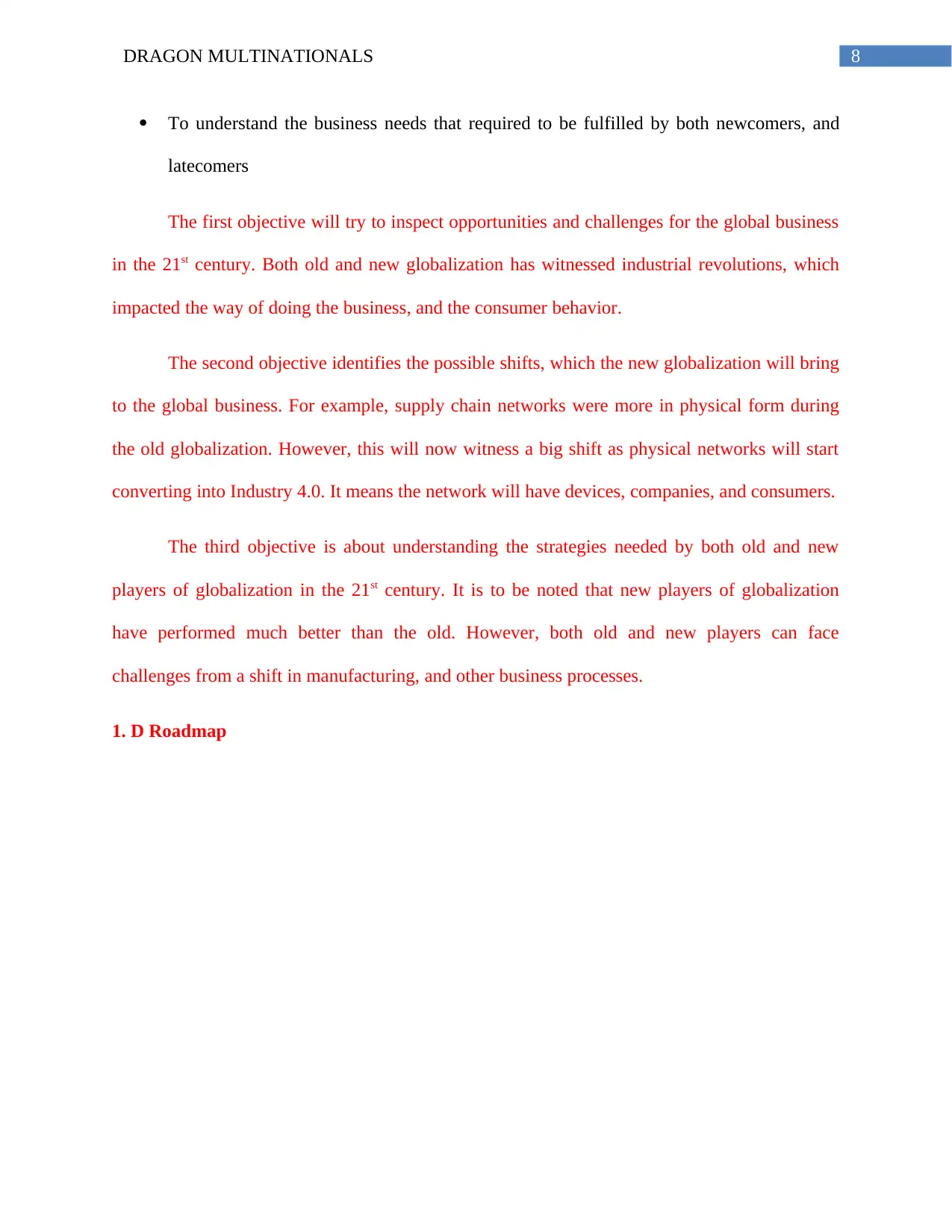
8DRAGON MULTINATIONALS
To understand the business needs that required to be fulfilled by both newcomers, and
latecomers
The first objective will try to inspect opportunities and challenges for the global business
in the 21st century. Both old and new globalization has witnessed industrial revolutions, which
impacted the way of doing the business, and the consumer behavior.
The second objective identifies the possible shifts, which the new globalization will bring
to the global business. For example, supply chain networks were more in physical form during
the old globalization. However, this will now witness a big shift as physical networks will start
converting into Industry 4.0. It means the network will have devices, companies, and consumers.
The third objective is about understanding the strategies needed by both old and new
players of globalization in the 21st century. It is to be noted that new players of globalization
have performed much better than the old. However, both old and new players can face
challenges from a shift in manufacturing, and other business processes.
1. D Roadmap
To understand the business needs that required to be fulfilled by both newcomers, and
latecomers
The first objective will try to inspect opportunities and challenges for the global business
in the 21st century. Both old and new globalization has witnessed industrial revolutions, which
impacted the way of doing the business, and the consumer behavior.
The second objective identifies the possible shifts, which the new globalization will bring
to the global business. For example, supply chain networks were more in physical form during
the old globalization. However, this will now witness a big shift as physical networks will start
converting into Industry 4.0. It means the network will have devices, companies, and consumers.
The third objective is about understanding the strategies needed by both old and new
players of globalization in the 21st century. It is to be noted that new players of globalization
have performed much better than the old. However, both old and new players can face
challenges from a shift in manufacturing, and other business processes.
1. D Roadmap
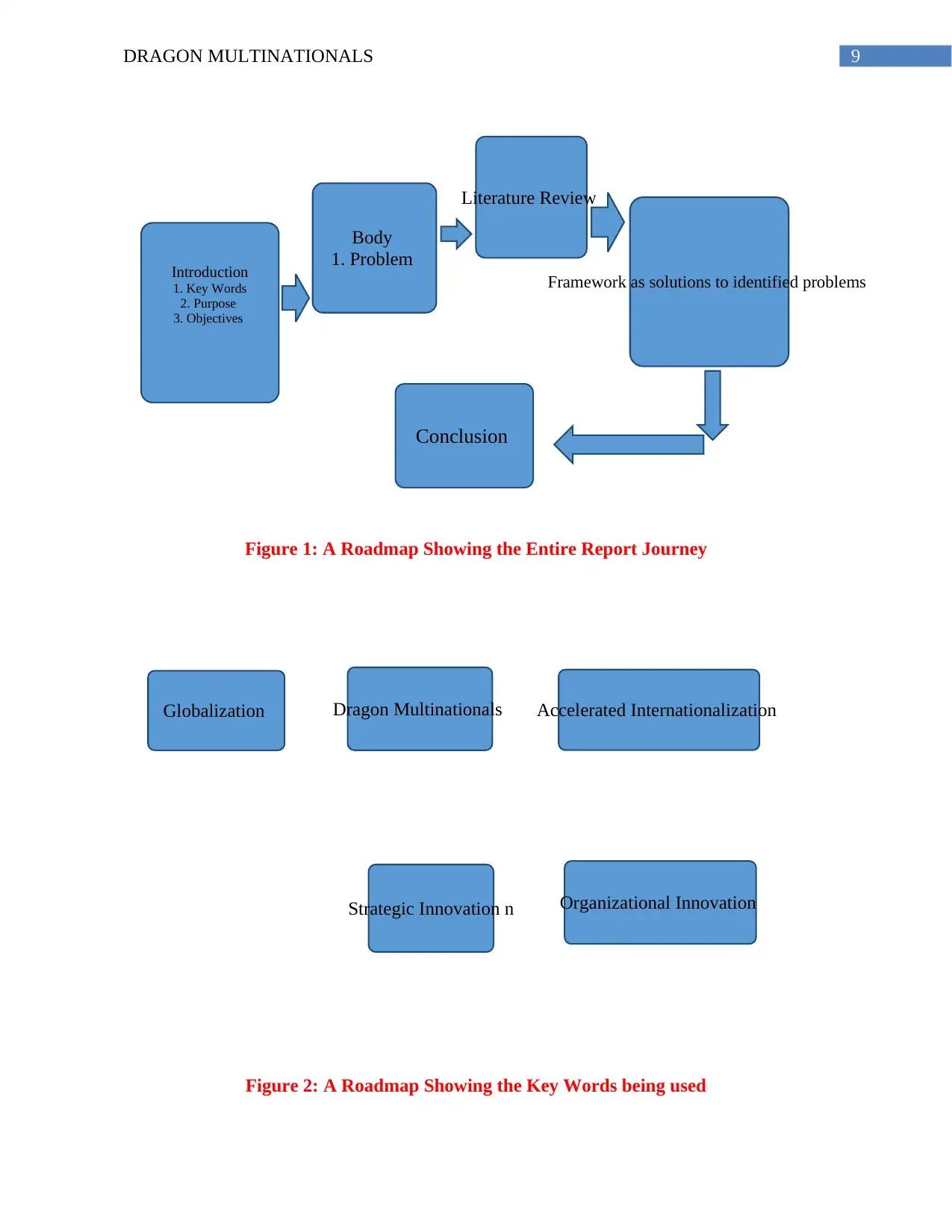
9DRAGON MULTINATIONALS
Introduction
1. Key Words
2. Purpose
3. Objectives
Body
1. Problem
Literature Review
Conclusion
Framework as solutions to identified problems
Dragon MultinationalsGlobalization
Strategic Innovation n
Accelerated Internationalization
Organizational Innovation
Figure 1: A Roadmap Showing the Entire Report Journey
Figure 2: A Roadmap Showing the Key Words being used
Introduction
1. Key Words
2. Purpose
3. Objectives
Body
1. Problem
Literature Review
Conclusion
Framework as solutions to identified problems
Dragon MultinationalsGlobalization
Strategic Innovation n
Accelerated Internationalization
Organizational Innovation
Figure 1: A Roadmap Showing the Entire Report Journey
Figure 2: A Roadmap Showing the Key Words being used
Secure Best Marks with AI Grader
Need help grading? Try our AI Grader for instant feedback on your assignments.
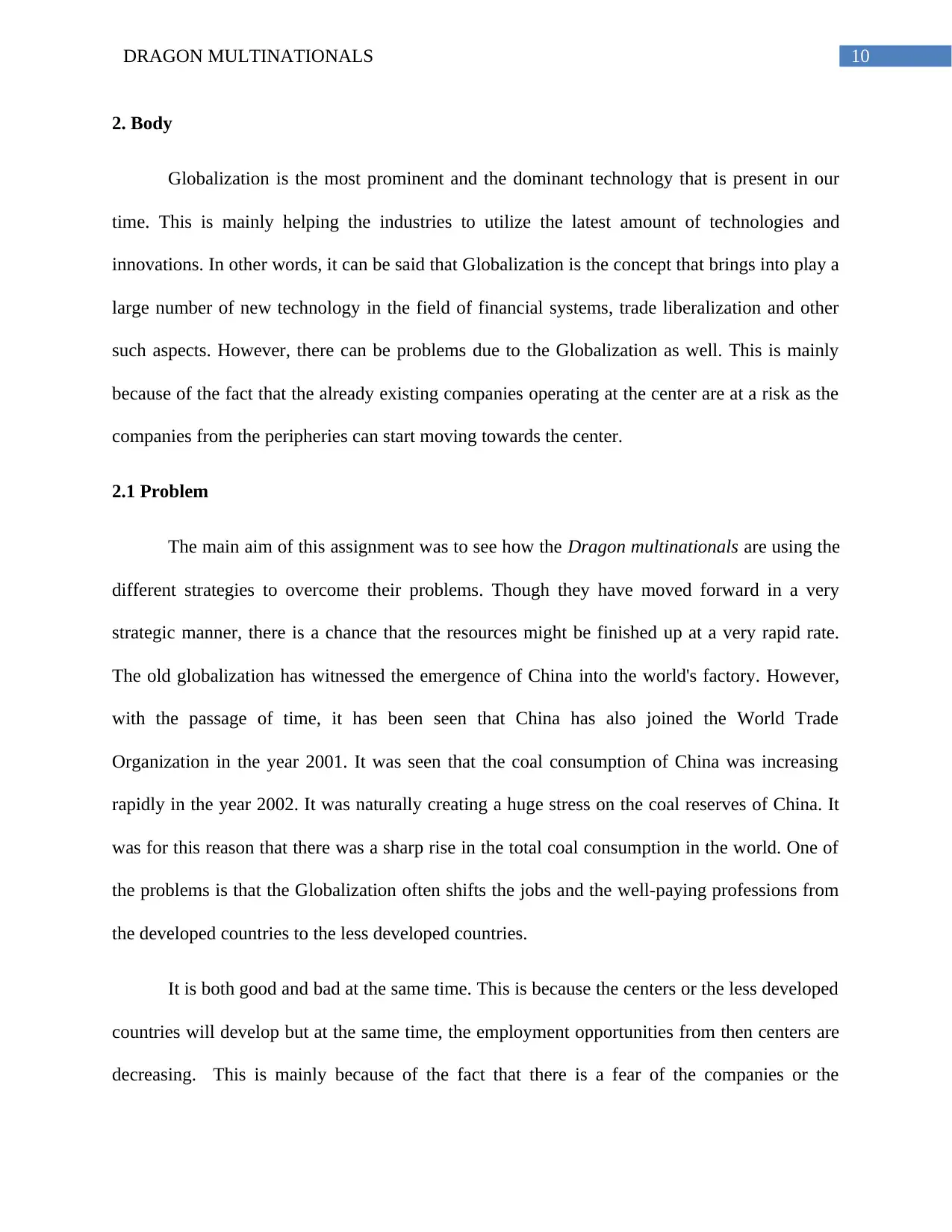
10DRAGON MULTINATIONALS
2. Body
Globalization is the most prominent and the dominant technology that is present in our
time. This is mainly helping the industries to utilize the latest amount of technologies and
innovations. In other words, it can be said that Globalization is the concept that brings into play a
large number of new technology in the field of financial systems, trade liberalization and other
such aspects. However, there can be problems due to the Globalization as well. This is mainly
because of the fact that the already existing companies operating at the center are at a risk as the
companies from the peripheries can start moving towards the center.
2.1 Problem
The main aim of this assignment was to see how the Dragon multinationals are using the
different strategies to overcome their problems. Though they have moved forward in a very
strategic manner, there is a chance that the resources might be finished up at a very rapid rate.
The old globalization has witnessed the emergence of China into the world's factory. However,
with the passage of time, it has been seen that China has also joined the World Trade
Organization in the year 2001. It was seen that the coal consumption of China was increasing
rapidly in the year 2002. It was naturally creating a huge stress on the coal reserves of China. It
was for this reason that there was a sharp rise in the total coal consumption in the world. One of
the problems is that the Globalization often shifts the jobs and the well-paying professions from
the developed countries to the less developed countries.
It is both good and bad at the same time. This is because the centers or the less developed
countries will develop but at the same time, the employment opportunities from then centers are
decreasing. This is mainly because of the fact that there is a fear of the companies or the
2. Body
Globalization is the most prominent and the dominant technology that is present in our
time. This is mainly helping the industries to utilize the latest amount of technologies and
innovations. In other words, it can be said that Globalization is the concept that brings into play a
large number of new technology in the field of financial systems, trade liberalization and other
such aspects. However, there can be problems due to the Globalization as well. This is mainly
because of the fact that the already existing companies operating at the center are at a risk as the
companies from the peripheries can start moving towards the center.
2.1 Problem
The main aim of this assignment was to see how the Dragon multinationals are using the
different strategies to overcome their problems. Though they have moved forward in a very
strategic manner, there is a chance that the resources might be finished up at a very rapid rate.
The old globalization has witnessed the emergence of China into the world's factory. However,
with the passage of time, it has been seen that China has also joined the World Trade
Organization in the year 2001. It was seen that the coal consumption of China was increasing
rapidly in the year 2002. It was naturally creating a huge stress on the coal reserves of China. It
was for this reason that there was a sharp rise in the total coal consumption in the world. One of
the problems is that the Globalization often shifts the jobs and the well-paying professions from
the developed countries to the less developed countries.
It is both good and bad at the same time. This is because the centers or the less developed
countries will develop but at the same time, the employment opportunities from then centers are
decreasing. This is mainly because of the fact that there is a fear of the companies or the
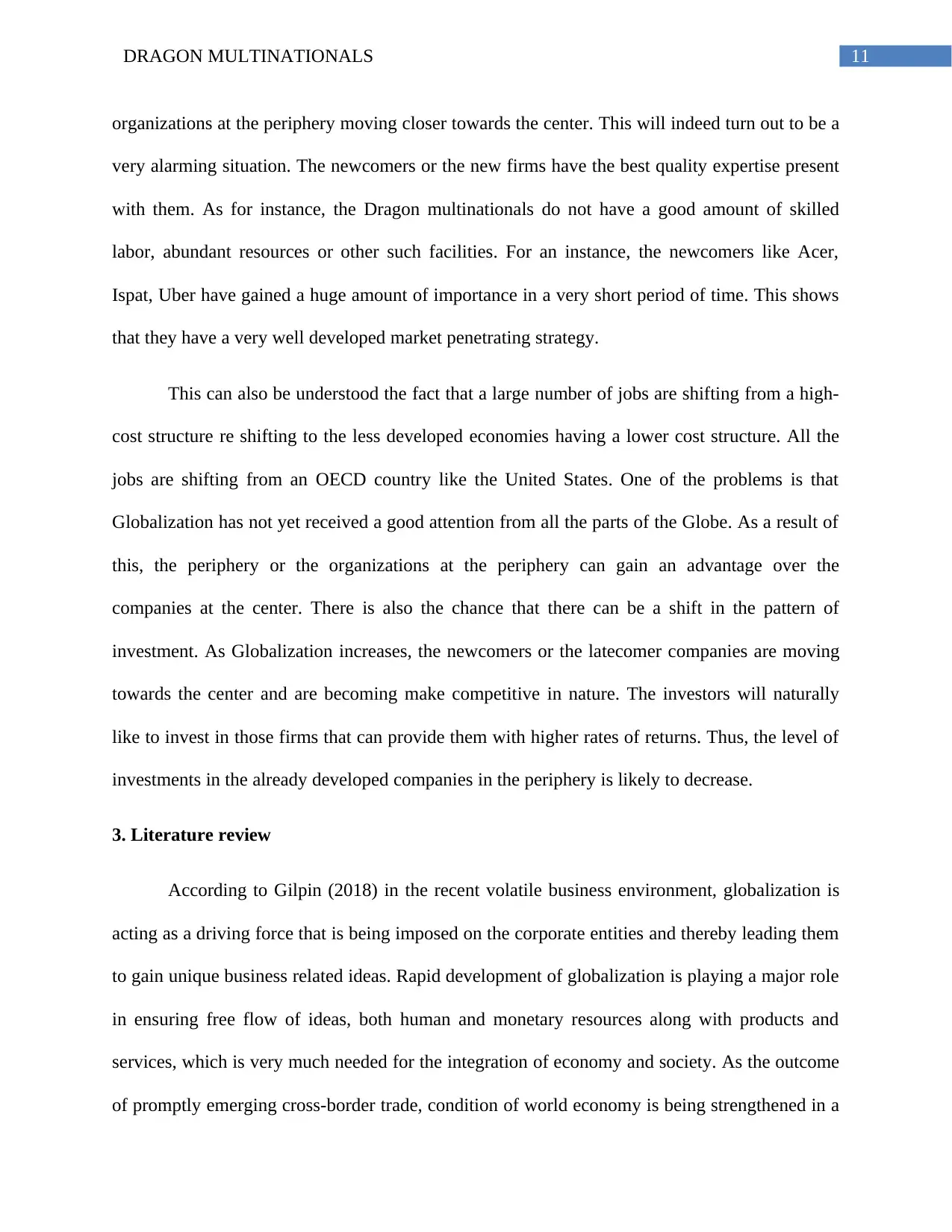
11DRAGON MULTINATIONALS
organizations at the periphery moving closer towards the center. This will indeed turn out to be a
very alarming situation. The newcomers or the new firms have the best quality expertise present
with them. As for instance, the Dragon multinationals do not have a good amount of skilled
labor, abundant resources or other such facilities. For an instance, the newcomers like Acer,
Ispat, Uber have gained a huge amount of importance in a very short period of time. This shows
that they have a very well developed market penetrating strategy.
This can also be understood the fact that a large number of jobs are shifting from a high-
cost structure re shifting to the less developed economies having a lower cost structure. All the
jobs are shifting from an OECD country like the United States. One of the problems is that
Globalization has not yet received a good attention from all the parts of the Globe. As a result of
this, the periphery or the organizations at the periphery can gain an advantage over the
companies at the center. There is also the chance that there can be a shift in the pattern of
investment. As Globalization increases, the newcomers or the latecomer companies are moving
towards the center and are becoming make competitive in nature. The investors will naturally
like to invest in those firms that can provide them with higher rates of returns. Thus, the level of
investments in the already developed companies in the periphery is likely to decrease.
3. Literature review
According to Gilpin (2018) in the recent volatile business environment, globalization is
acting as a driving force that is being imposed on the corporate entities and thereby leading them
to gain unique business related ideas. Rapid development of globalization is playing a major role
in ensuring free flow of ideas, both human and monetary resources along with products and
services, which is very much needed for the integration of economy and society. As the outcome
of promptly emerging cross-border trade, condition of world economy is being strengthened in a
organizations at the periphery moving closer towards the center. This will indeed turn out to be a
very alarming situation. The newcomers or the new firms have the best quality expertise present
with them. As for instance, the Dragon multinationals do not have a good amount of skilled
labor, abundant resources or other such facilities. For an instance, the newcomers like Acer,
Ispat, Uber have gained a huge amount of importance in a very short period of time. This shows
that they have a very well developed market penetrating strategy.
This can also be understood the fact that a large number of jobs are shifting from a high-
cost structure re shifting to the less developed economies having a lower cost structure. All the
jobs are shifting from an OECD country like the United States. One of the problems is that
Globalization has not yet received a good attention from all the parts of the Globe. As a result of
this, the periphery or the organizations at the periphery can gain an advantage over the
companies at the center. There is also the chance that there can be a shift in the pattern of
investment. As Globalization increases, the newcomers or the latecomer companies are moving
towards the center and are becoming make competitive in nature. The investors will naturally
like to invest in those firms that can provide them with higher rates of returns. Thus, the level of
investments in the already developed companies in the periphery is likely to decrease.
3. Literature review
According to Gilpin (2018) in the recent volatile business environment, globalization is
acting as a driving force that is being imposed on the corporate entities and thereby leading them
to gain unique business related ideas. Rapid development of globalization is playing a major role
in ensuring free flow of ideas, both human and monetary resources along with products and
services, which is very much needed for the integration of economy and society. As the outcome
of promptly emerging cross-border trade, condition of world economy is being strengthened in a
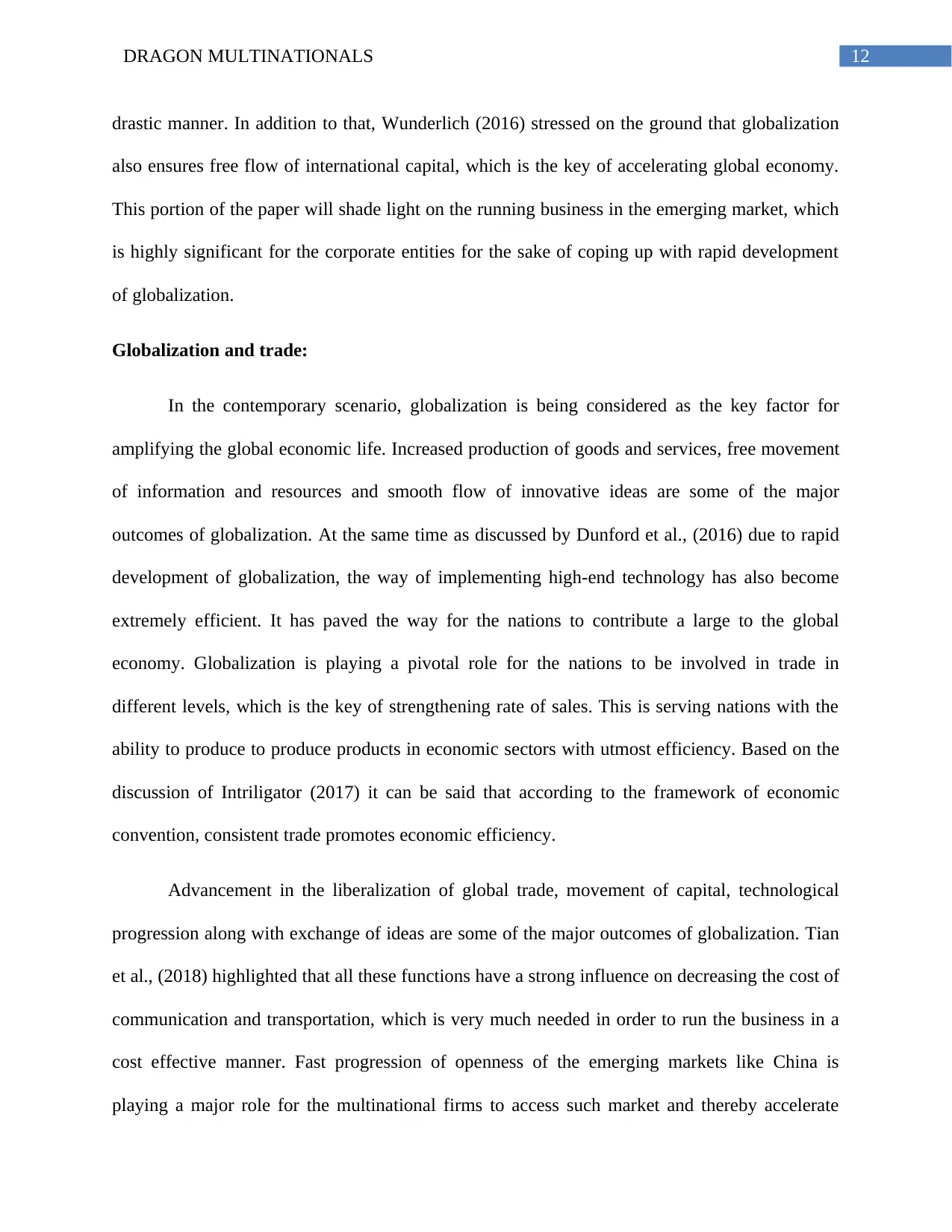
12DRAGON MULTINATIONALS
drastic manner. In addition to that, Wunderlich (2016) stressed on the ground that globalization
also ensures free flow of international capital, which is the key of accelerating global economy.
This portion of the paper will shade light on the running business in the emerging market, which
is highly significant for the corporate entities for the sake of coping up with rapid development
of globalization.
Globalization and trade:
In the contemporary scenario, globalization is being considered as the key factor for
amplifying the global economic life. Increased production of goods and services, free movement
of information and resources and smooth flow of innovative ideas are some of the major
outcomes of globalization. At the same time as discussed by Dunford et al., (2016) due to rapid
development of globalization, the way of implementing high-end technology has also become
extremely efficient. It has paved the way for the nations to contribute a large to the global
economy. Globalization is playing a pivotal role for the nations to be involved in trade in
different levels, which is the key of strengthening rate of sales. This is serving nations with the
ability to produce to produce products in economic sectors with utmost efficiency. Based on the
discussion of Intriligator (2017) it can be said that according to the framework of economic
convention, consistent trade promotes economic efficiency.
Advancement in the liberalization of global trade, movement of capital, technological
progression along with exchange of ideas are some of the major outcomes of globalization. Tian
et al., (2018) highlighted that all these functions have a strong influence on decreasing the cost of
communication and transportation, which is very much needed in order to run the business in a
cost effective manner. Fast progression of openness of the emerging markets like China is
playing a major role for the multinational firms to access such market and thereby accelerate
drastic manner. In addition to that, Wunderlich (2016) stressed on the ground that globalization
also ensures free flow of international capital, which is the key of accelerating global economy.
This portion of the paper will shade light on the running business in the emerging market, which
is highly significant for the corporate entities for the sake of coping up with rapid development
of globalization.
Globalization and trade:
In the contemporary scenario, globalization is being considered as the key factor for
amplifying the global economic life. Increased production of goods and services, free movement
of information and resources and smooth flow of innovative ideas are some of the major
outcomes of globalization. At the same time as discussed by Dunford et al., (2016) due to rapid
development of globalization, the way of implementing high-end technology has also become
extremely efficient. It has paved the way for the nations to contribute a large to the global
economy. Globalization is playing a pivotal role for the nations to be involved in trade in
different levels, which is the key of strengthening rate of sales. This is serving nations with the
ability to produce to produce products in economic sectors with utmost efficiency. Based on the
discussion of Intriligator (2017) it can be said that according to the framework of economic
convention, consistent trade promotes economic efficiency.
Advancement in the liberalization of global trade, movement of capital, technological
progression along with exchange of ideas are some of the major outcomes of globalization. Tian
et al., (2018) highlighted that all these functions have a strong influence on decreasing the cost of
communication and transportation, which is very much needed in order to run the business in a
cost effective manner. Fast progression of openness of the emerging markets like China is
playing a major role for the multinational firms to access such market and thereby accelerate
Paraphrase This Document
Need a fresh take? Get an instant paraphrase of this document with our AI Paraphraser
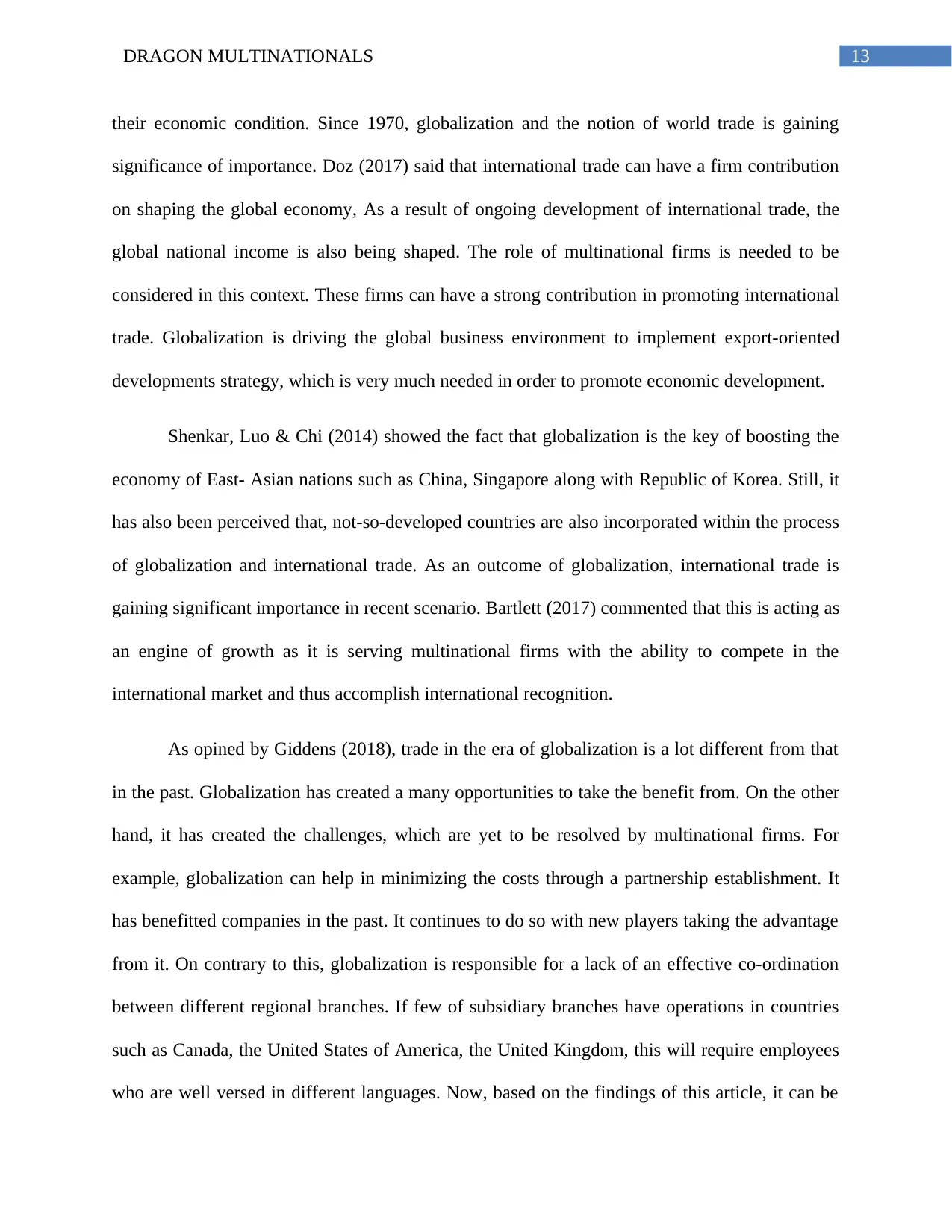
13DRAGON MULTINATIONALS
their economic condition. Since 1970, globalization and the notion of world trade is gaining
significance of importance. Doz (2017) said that international trade can have a firm contribution
on shaping the global economy, As a result of ongoing development of international trade, the
global national income is also being shaped. The role of multinational firms is needed to be
considered in this context. These firms can have a strong contribution in promoting international
trade. Globalization is driving the global business environment to implement export-oriented
developments strategy, which is very much needed in order to promote economic development.
Shenkar, Luo & Chi (2014) showed the fact that globalization is the key of boosting the
economy of East- Asian nations such as China, Singapore along with Republic of Korea. Still, it
has also been perceived that, not-so-developed countries are also incorporated within the process
of globalization and international trade. As an outcome of globalization, international trade is
gaining significant importance in recent scenario. Bartlett (2017) commented that this is acting as
an engine of growth as it is serving multinational firms with the ability to compete in the
international market and thus accomplish international recognition.
As opined by Giddens (2018), trade in the era of globalization is a lot different from that
in the past. Globalization has created a many opportunities to take the benefit from. On the other
hand, it has created the challenges, which are yet to be resolved by multinational firms. For
example, globalization can help in minimizing the costs through a partnership establishment. It
has benefitted companies in the past. It continues to do so with new players taking the advantage
from it. On contrary to this, globalization is responsible for a lack of an effective co-ordination
between different regional branches. If few of subsidiary branches have operations in countries
such as Canada, the United States of America, the United Kingdom, this will require employees
who are well versed in different languages. Now, based on the findings of this article, it can be
their economic condition. Since 1970, globalization and the notion of world trade is gaining
significance of importance. Doz (2017) said that international trade can have a firm contribution
on shaping the global economy, As a result of ongoing development of international trade, the
global national income is also being shaped. The role of multinational firms is needed to be
considered in this context. These firms can have a strong contribution in promoting international
trade. Globalization is driving the global business environment to implement export-oriented
developments strategy, which is very much needed in order to promote economic development.
Shenkar, Luo & Chi (2014) showed the fact that globalization is the key of boosting the
economy of East- Asian nations such as China, Singapore along with Republic of Korea. Still, it
has also been perceived that, not-so-developed countries are also incorporated within the process
of globalization and international trade. As an outcome of globalization, international trade is
gaining significant importance in recent scenario. Bartlett (2017) commented that this is acting as
an engine of growth as it is serving multinational firms with the ability to compete in the
international market and thus accomplish international recognition.
As opined by Giddens (2018), trade in the era of globalization is a lot different from that
in the past. Globalization has created a many opportunities to take the benefit from. On the other
hand, it has created the challenges, which are yet to be resolved by multinational firms. For
example, globalization can help in minimizing the costs through a partnership establishment. It
has benefitted companies in the past. It continues to do so with new players taking the advantage
from it. On contrary to this, globalization is responsible for a lack of an effective co-ordination
between different regional branches. If few of subsidiary branches have operations in countries
such as Canada, the United States of America, the United Kingdom, this will require employees
who are well versed in different languages. Now, based on the findings of this article, it can be
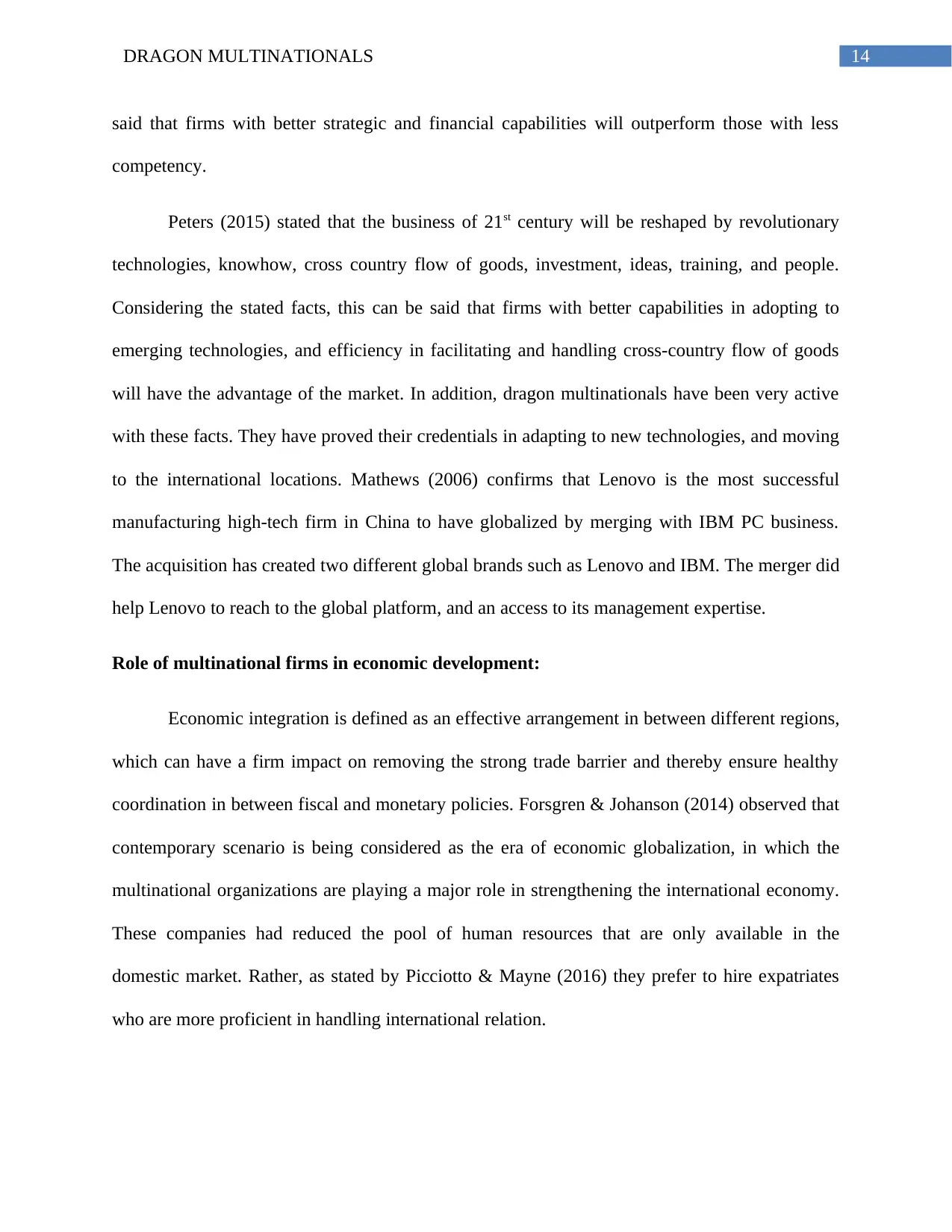
14DRAGON MULTINATIONALS
said that firms with better strategic and financial capabilities will outperform those with less
competency.
Peters (2015) stated that the business of 21st century will be reshaped by revolutionary
technologies, knowhow, cross country flow of goods, investment, ideas, training, and people.
Considering the stated facts, this can be said that firms with better capabilities in adopting to
emerging technologies, and efficiency in facilitating and handling cross-country flow of goods
will have the advantage of the market. In addition, dragon multinationals have been very active
with these facts. They have proved their credentials in adapting to new technologies, and moving
to the international locations. Mathews (2006) confirms that Lenovo is the most successful
manufacturing high-tech firm in China to have globalized by merging with IBM PC business.
The acquisition has created two different global brands such as Lenovo and IBM. The merger did
help Lenovo to reach to the global platform, and an access to its management expertise.
Role of multinational firms in economic development:
Economic integration is defined as an effective arrangement in between different regions,
which can have a firm impact on removing the strong trade barrier and thereby ensure healthy
coordination in between fiscal and monetary policies. Forsgren & Johanson (2014) observed that
contemporary scenario is being considered as the era of economic globalization, in which the
multinational organizations are playing a major role in strengthening the international economy.
These companies had reduced the pool of human resources that are only available in the
domestic market. Rather, as stated by Picciotto & Mayne (2016) they prefer to hire expatriates
who are more proficient in handling international relation.
said that firms with better strategic and financial capabilities will outperform those with less
competency.
Peters (2015) stated that the business of 21st century will be reshaped by revolutionary
technologies, knowhow, cross country flow of goods, investment, ideas, training, and people.
Considering the stated facts, this can be said that firms with better capabilities in adopting to
emerging technologies, and efficiency in facilitating and handling cross-country flow of goods
will have the advantage of the market. In addition, dragon multinationals have been very active
with these facts. They have proved their credentials in adapting to new technologies, and moving
to the international locations. Mathews (2006) confirms that Lenovo is the most successful
manufacturing high-tech firm in China to have globalized by merging with IBM PC business.
The acquisition has created two different global brands such as Lenovo and IBM. The merger did
help Lenovo to reach to the global platform, and an access to its management expertise.
Role of multinational firms in economic development:
Economic integration is defined as an effective arrangement in between different regions,
which can have a firm impact on removing the strong trade barrier and thereby ensure healthy
coordination in between fiscal and monetary policies. Forsgren & Johanson (2014) observed that
contemporary scenario is being considered as the era of economic globalization, in which the
multinational organizations are playing a major role in strengthening the international economy.
These companies had reduced the pool of human resources that are only available in the
domestic market. Rather, as stated by Picciotto & Mayne (2016) they prefer to hire expatriates
who are more proficient in handling international relation.
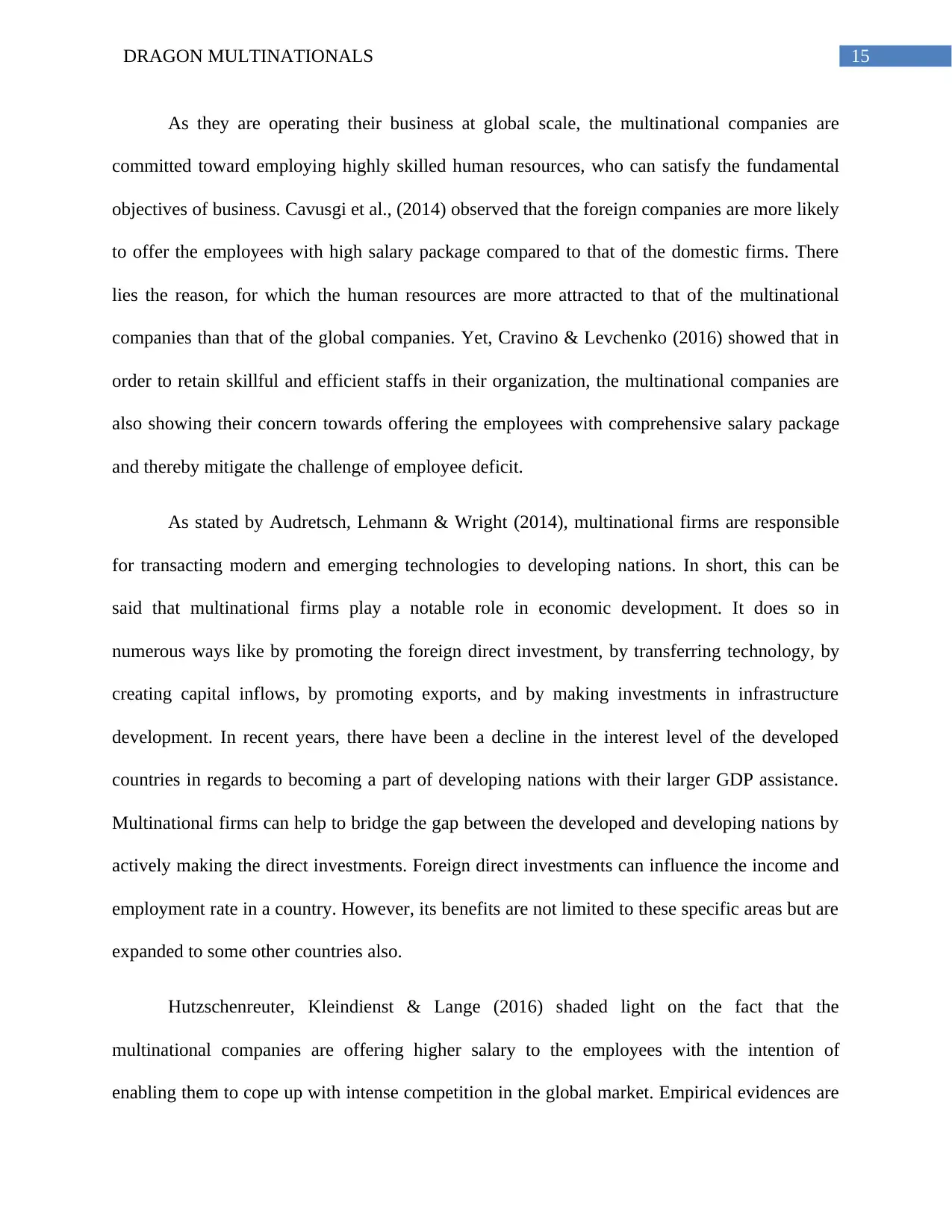
15DRAGON MULTINATIONALS
As they are operating their business at global scale, the multinational companies are
committed toward employing highly skilled human resources, who can satisfy the fundamental
objectives of business. Cavusgi et al., (2014) observed that the foreign companies are more likely
to offer the employees with high salary package compared to that of the domestic firms. There
lies the reason, for which the human resources are more attracted to that of the multinational
companies than that of the global companies. Yet, Cravino & Levchenko (2016) showed that in
order to retain skillful and efficient staffs in their organization, the multinational companies are
also showing their concern towards offering the employees with comprehensive salary package
and thereby mitigate the challenge of employee deficit.
As stated by Audretsch, Lehmann & Wright (2014), multinational firms are responsible
for transacting modern and emerging technologies to developing nations. In short, this can be
said that multinational firms play a notable role in economic development. It does so in
numerous ways like by promoting the foreign direct investment, by transferring technology, by
creating capital inflows, by promoting exports, and by making investments in infrastructure
development. In recent years, there have been a decline in the interest level of the developed
countries in regards to becoming a part of developing nations with their larger GDP assistance.
Multinational firms can help to bridge the gap between the developed and developing nations by
actively making the direct investments. Foreign direct investments can influence the income and
employment rate in a country. However, its benefits are not limited to these specific areas but are
expanded to some other countries also.
Hutzschenreuter, Kleindienst & Lange (2016) shaded light on the fact that the
multinational companies are offering higher salary to the employees with the intention of
enabling them to cope up with intense competition in the global market. Empirical evidences are
As they are operating their business at global scale, the multinational companies are
committed toward employing highly skilled human resources, who can satisfy the fundamental
objectives of business. Cavusgi et al., (2014) observed that the foreign companies are more likely
to offer the employees with high salary package compared to that of the domestic firms. There
lies the reason, for which the human resources are more attracted to that of the multinational
companies than that of the global companies. Yet, Cravino & Levchenko (2016) showed that in
order to retain skillful and efficient staffs in their organization, the multinational companies are
also showing their concern towards offering the employees with comprehensive salary package
and thereby mitigate the challenge of employee deficit.
As stated by Audretsch, Lehmann & Wright (2014), multinational firms are responsible
for transacting modern and emerging technologies to developing nations. In short, this can be
said that multinational firms play a notable role in economic development. It does so in
numerous ways like by promoting the foreign direct investment, by transferring technology, by
creating capital inflows, by promoting exports, and by making investments in infrastructure
development. In recent years, there have been a decline in the interest level of the developed
countries in regards to becoming a part of developing nations with their larger GDP assistance.
Multinational firms can help to bridge the gap between the developed and developing nations by
actively making the direct investments. Foreign direct investments can influence the income and
employment rate in a country. However, its benefits are not limited to these specific areas but are
expanded to some other countries also.
Hutzschenreuter, Kleindienst & Lange (2016) shaded light on the fact that the
multinational companies are offering higher salary to the employees with the intention of
enabling them to cope up with intense competition in the global market. Empirical evidences are
Secure Best Marks with AI Grader
Need help grading? Try our AI Grader for instant feedback on your assignments.
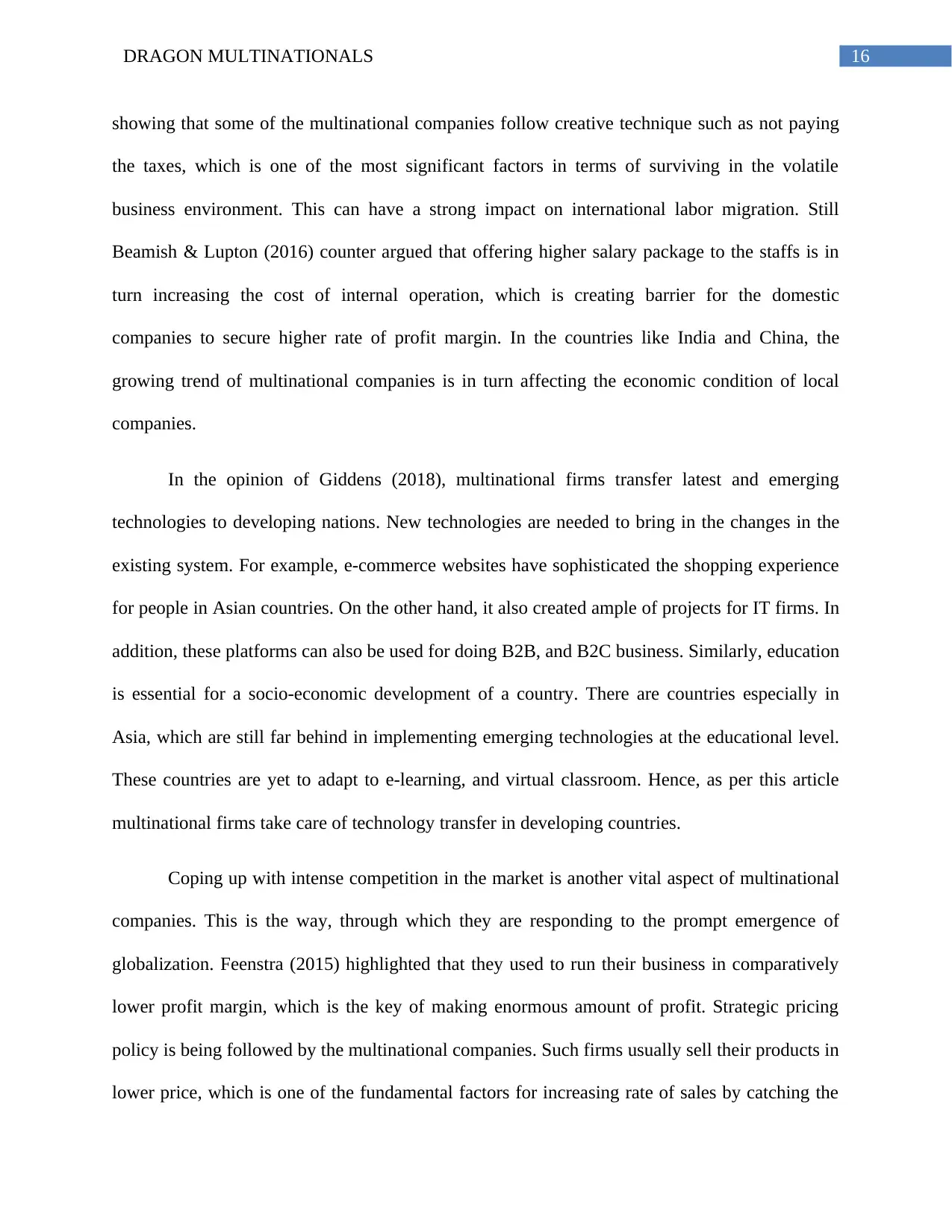
16DRAGON MULTINATIONALS
showing that some of the multinational companies follow creative technique such as not paying
the taxes, which is one of the most significant factors in terms of surviving in the volatile
business environment. This can have a strong impact on international labor migration. Still
Beamish & Lupton (2016) counter argued that offering higher salary package to the staffs is in
turn increasing the cost of internal operation, which is creating barrier for the domestic
companies to secure higher rate of profit margin. In the countries like India and China, the
growing trend of multinational companies is in turn affecting the economic condition of local
companies.
In the opinion of Giddens (2018), multinational firms transfer latest and emerging
technologies to developing nations. New technologies are needed to bring in the changes in the
existing system. For example, e-commerce websites have sophisticated the shopping experience
for people in Asian countries. On the other hand, it also created ample of projects for IT firms. In
addition, these platforms can also be used for doing B2B, and B2C business. Similarly, education
is essential for a socio-economic development of a country. There are countries especially in
Asia, which are still far behind in implementing emerging technologies at the educational level.
These countries are yet to adapt to e-learning, and virtual classroom. Hence, as per this article
multinational firms take care of technology transfer in developing countries.
Coping up with intense competition in the market is another vital aspect of multinational
companies. This is the way, through which they are responding to the prompt emergence of
globalization. Feenstra (2015) highlighted that they used to run their business in comparatively
lower profit margin, which is the key of making enormous amount of profit. Strategic pricing
policy is being followed by the multinational companies. Such firms usually sell their products in
lower price, which is one of the fundamental factors for increasing rate of sales by catching the
showing that some of the multinational companies follow creative technique such as not paying
the taxes, which is one of the most significant factors in terms of surviving in the volatile
business environment. This can have a strong impact on international labor migration. Still
Beamish & Lupton (2016) counter argued that offering higher salary package to the staffs is in
turn increasing the cost of internal operation, which is creating barrier for the domestic
companies to secure higher rate of profit margin. In the countries like India and China, the
growing trend of multinational companies is in turn affecting the economic condition of local
companies.
In the opinion of Giddens (2018), multinational firms transfer latest and emerging
technologies to developing nations. New technologies are needed to bring in the changes in the
existing system. For example, e-commerce websites have sophisticated the shopping experience
for people in Asian countries. On the other hand, it also created ample of projects for IT firms. In
addition, these platforms can also be used for doing B2B, and B2C business. Similarly, education
is essential for a socio-economic development of a country. There are countries especially in
Asia, which are still far behind in implementing emerging technologies at the educational level.
These countries are yet to adapt to e-learning, and virtual classroom. Hence, as per this article
multinational firms take care of technology transfer in developing countries.
Coping up with intense competition in the market is another vital aspect of multinational
companies. This is the way, through which they are responding to the prompt emergence of
globalization. Feenstra (2015) highlighted that they used to run their business in comparatively
lower profit margin, which is the key of making enormous amount of profit. Strategic pricing
policy is being followed by the multinational companies. Such firms usually sell their products in
lower price, which is one of the fundamental factors for increasing rate of sales by catching the
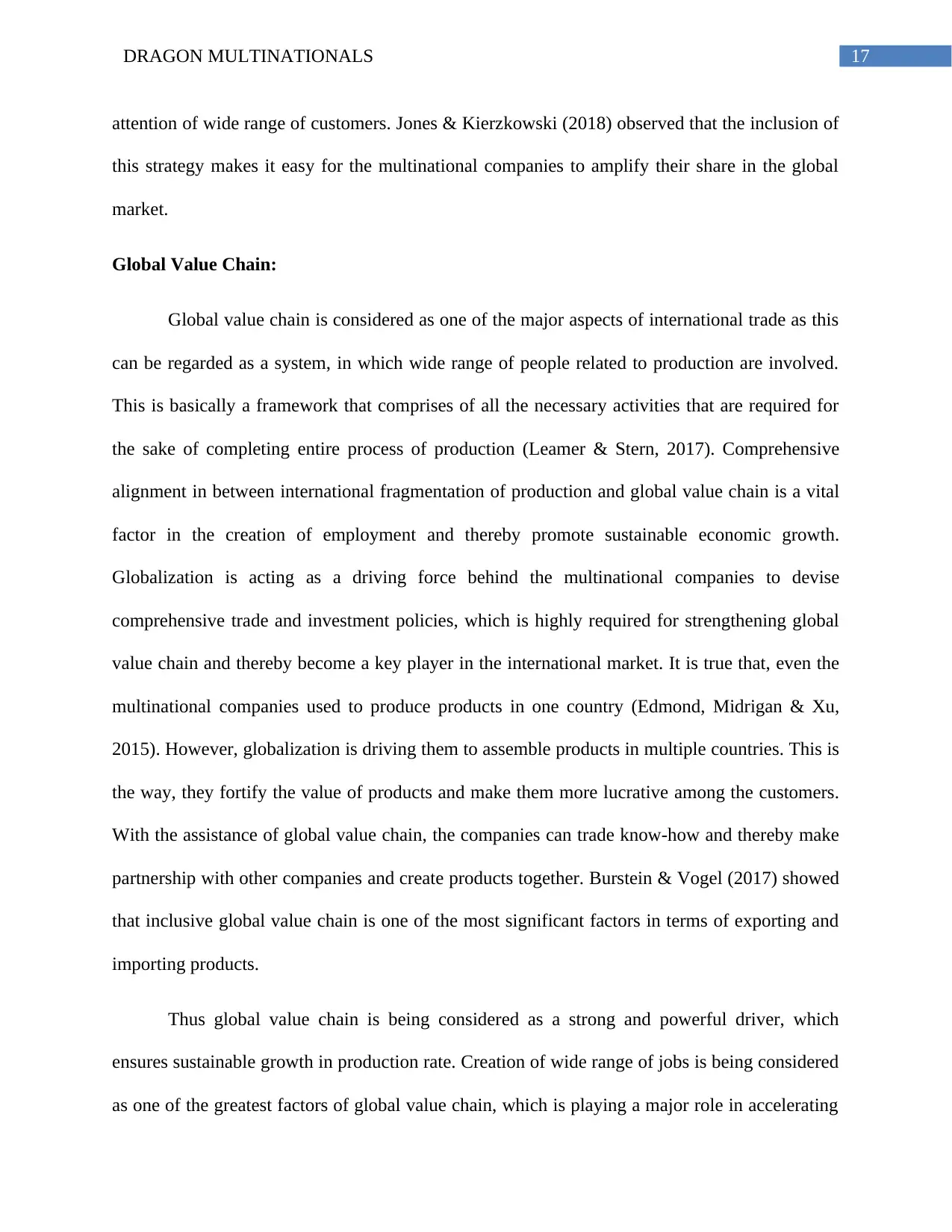
17DRAGON MULTINATIONALS
attention of wide range of customers. Jones & Kierzkowski (2018) observed that the inclusion of
this strategy makes it easy for the multinational companies to amplify their share in the global
market.
Global Value Chain:
Global value chain is considered as one of the major aspects of international trade as this
can be regarded as a system, in which wide range of people related to production are involved.
This is basically a framework that comprises of all the necessary activities that are required for
the sake of completing entire process of production (Leamer & Stern, 2017). Comprehensive
alignment in between international fragmentation of production and global value chain is a vital
factor in the creation of employment and thereby promote sustainable economic growth.
Globalization is acting as a driving force behind the multinational companies to devise
comprehensive trade and investment policies, which is highly required for strengthening global
value chain and thereby become a key player in the international market. It is true that, even the
multinational companies used to produce products in one country (Edmond, Midrigan & Xu,
2015). However, globalization is driving them to assemble products in multiple countries. This is
the way, they fortify the value of products and make them more lucrative among the customers.
With the assistance of global value chain, the companies can trade know-how and thereby make
partnership with other companies and create products together. Burstein & Vogel (2017) showed
that inclusive global value chain is one of the most significant factors in terms of exporting and
importing products.
Thus global value chain is being considered as a strong and powerful driver, which
ensures sustainable growth in production rate. Creation of wide range of jobs is being considered
as one of the greatest factors of global value chain, which is playing a major role in accelerating
attention of wide range of customers. Jones & Kierzkowski (2018) observed that the inclusion of
this strategy makes it easy for the multinational companies to amplify their share in the global
market.
Global Value Chain:
Global value chain is considered as one of the major aspects of international trade as this
can be regarded as a system, in which wide range of people related to production are involved.
This is basically a framework that comprises of all the necessary activities that are required for
the sake of completing entire process of production (Leamer & Stern, 2017). Comprehensive
alignment in between international fragmentation of production and global value chain is a vital
factor in the creation of employment and thereby promote sustainable economic growth.
Globalization is acting as a driving force behind the multinational companies to devise
comprehensive trade and investment policies, which is highly required for strengthening global
value chain and thereby become a key player in the international market. It is true that, even the
multinational companies used to produce products in one country (Edmond, Midrigan & Xu,
2015). However, globalization is driving them to assemble products in multiple countries. This is
the way, they fortify the value of products and make them more lucrative among the customers.
With the assistance of global value chain, the companies can trade know-how and thereby make
partnership with other companies and create products together. Burstein & Vogel (2017) showed
that inclusive global value chain is one of the most significant factors in terms of exporting and
importing products.
Thus global value chain is being considered as a strong and powerful driver, which
ensures sustainable growth in production rate. Creation of wide range of jobs is being considered
as one of the greatest factors of global value chain, which is playing a major role in accelerating
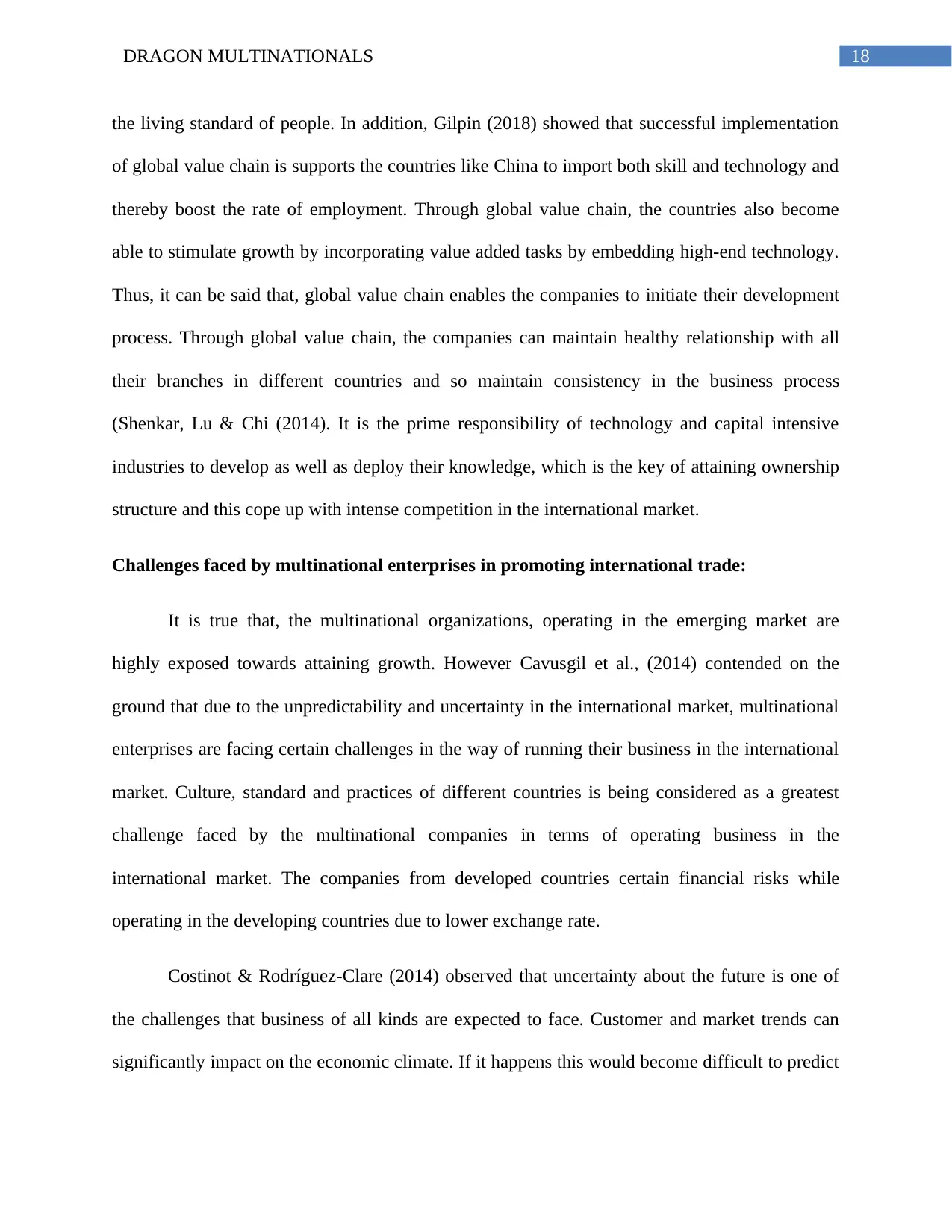
18DRAGON MULTINATIONALS
the living standard of people. In addition, Gilpin (2018) showed that successful implementation
of global value chain is supports the countries like China to import both skill and technology and
thereby boost the rate of employment. Through global value chain, the countries also become
able to stimulate growth by incorporating value added tasks by embedding high-end technology.
Thus, it can be said that, global value chain enables the companies to initiate their development
process. Through global value chain, the companies can maintain healthy relationship with all
their branches in different countries and so maintain consistency in the business process
(Shenkar, Lu & Chi (2014). It is the prime responsibility of technology and capital intensive
industries to develop as well as deploy their knowledge, which is the key of attaining ownership
structure and this cope up with intense competition in the international market.
Challenges faced by multinational enterprises in promoting international trade:
It is true that, the multinational organizations, operating in the emerging market are
highly exposed towards attaining growth. However Cavusgil et al., (2014) contended on the
ground that due to the unpredictability and uncertainty in the international market, multinational
enterprises are facing certain challenges in the way of running their business in the international
market. Culture, standard and practices of different countries is being considered as a greatest
challenge faced by the multinational companies in terms of operating business in the
international market. The companies from developed countries certain financial risks while
operating in the developing countries due to lower exchange rate.
Costinot & Rodríguez-Clare (2014) observed that uncertainty about the future is one of
the challenges that business of all kinds are expected to face. Customer and market trends can
significantly impact on the economic climate. If it happens this would become difficult to predict
the living standard of people. In addition, Gilpin (2018) showed that successful implementation
of global value chain is supports the countries like China to import both skill and technology and
thereby boost the rate of employment. Through global value chain, the countries also become
able to stimulate growth by incorporating value added tasks by embedding high-end technology.
Thus, it can be said that, global value chain enables the companies to initiate their development
process. Through global value chain, the companies can maintain healthy relationship with all
their branches in different countries and so maintain consistency in the business process
(Shenkar, Lu & Chi (2014). It is the prime responsibility of technology and capital intensive
industries to develop as well as deploy their knowledge, which is the key of attaining ownership
structure and this cope up with intense competition in the international market.
Challenges faced by multinational enterprises in promoting international trade:
It is true that, the multinational organizations, operating in the emerging market are
highly exposed towards attaining growth. However Cavusgil et al., (2014) contended on the
ground that due to the unpredictability and uncertainty in the international market, multinational
enterprises are facing certain challenges in the way of running their business in the international
market. Culture, standard and practices of different countries is being considered as a greatest
challenge faced by the multinational companies in terms of operating business in the
international market. The companies from developed countries certain financial risks while
operating in the developing countries due to lower exchange rate.
Costinot & Rodríguez-Clare (2014) observed that uncertainty about the future is one of
the challenges that business of all kinds are expected to face. Customer and market trends can
significantly impact on the economic climate. If it happens this would become difficult to predict
Paraphrase This Document
Need a fresh take? Get an instant paraphrase of this document with our AI Paraphraser
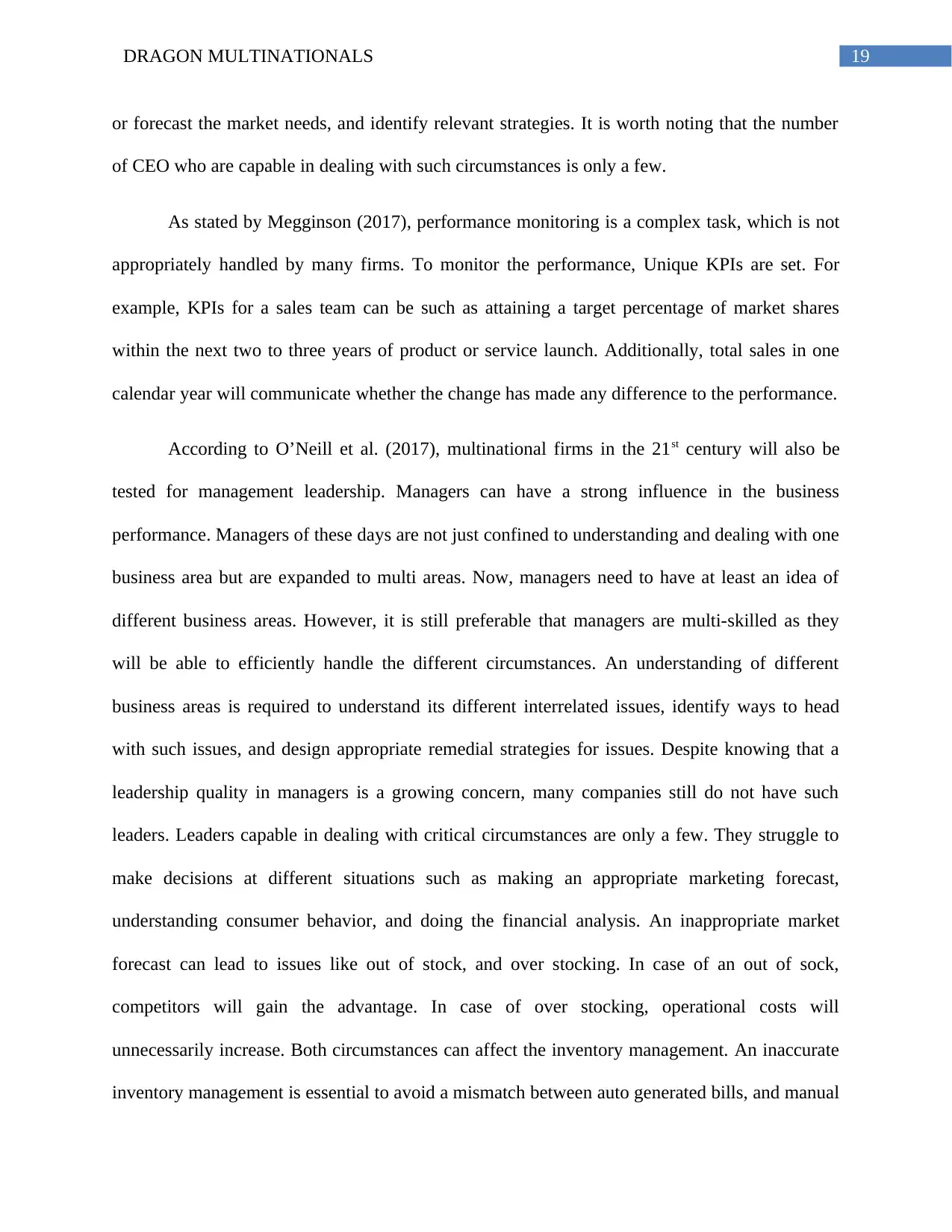
19DRAGON MULTINATIONALS
or forecast the market needs, and identify relevant strategies. It is worth noting that the number
of CEO who are capable in dealing with such circumstances is only a few.
As stated by Megginson (2017), performance monitoring is a complex task, which is not
appropriately handled by many firms. To monitor the performance, Unique KPIs are set. For
example, KPIs for a sales team can be such as attaining a target percentage of market shares
within the next two to three years of product or service launch. Additionally, total sales in one
calendar year will communicate whether the change has made any difference to the performance.
According to O’Neill et al. (2017), multinational firms in the 21st century will also be
tested for management leadership. Managers can have a strong influence in the business
performance. Managers of these days are not just confined to understanding and dealing with one
business area but are expanded to multi areas. Now, managers need to have at least an idea of
different business areas. However, it is still preferable that managers are multi-skilled as they
will be able to efficiently handle the different circumstances. An understanding of different
business areas is required to understand its different interrelated issues, identify ways to head
with such issues, and design appropriate remedial strategies for issues. Despite knowing that a
leadership quality in managers is a growing concern, many companies still do not have such
leaders. Leaders capable in dealing with critical circumstances are only a few. They struggle to
make decisions at different situations such as making an appropriate marketing forecast,
understanding consumer behavior, and doing the financial analysis. An inappropriate market
forecast can lead to issues like out of stock, and over stocking. In case of an out of sock,
competitors will gain the advantage. In case of over stocking, operational costs will
unnecessarily increase. Both circumstances can affect the inventory management. An inaccurate
inventory management is essential to avoid a mismatch between auto generated bills, and manual
or forecast the market needs, and identify relevant strategies. It is worth noting that the number
of CEO who are capable in dealing with such circumstances is only a few.
As stated by Megginson (2017), performance monitoring is a complex task, which is not
appropriately handled by many firms. To monitor the performance, Unique KPIs are set. For
example, KPIs for a sales team can be such as attaining a target percentage of market shares
within the next two to three years of product or service launch. Additionally, total sales in one
calendar year will communicate whether the change has made any difference to the performance.
According to O’Neill et al. (2017), multinational firms in the 21st century will also be
tested for management leadership. Managers can have a strong influence in the business
performance. Managers of these days are not just confined to understanding and dealing with one
business area but are expanded to multi areas. Now, managers need to have at least an idea of
different business areas. However, it is still preferable that managers are multi-skilled as they
will be able to efficiently handle the different circumstances. An understanding of different
business areas is required to understand its different interrelated issues, identify ways to head
with such issues, and design appropriate remedial strategies for issues. Despite knowing that a
leadership quality in managers is a growing concern, many companies still do not have such
leaders. Leaders capable in dealing with critical circumstances are only a few. They struggle to
make decisions at different situations such as making an appropriate marketing forecast,
understanding consumer behavior, and doing the financial analysis. An inappropriate market
forecast can lead to issues like out of stock, and over stocking. In case of an out of sock,
competitors will gain the advantage. In case of over stocking, operational costs will
unnecessarily increase. Both circumstances can affect the inventory management. An inaccurate
inventory management is essential to avoid a mismatch between auto generated bills, and manual
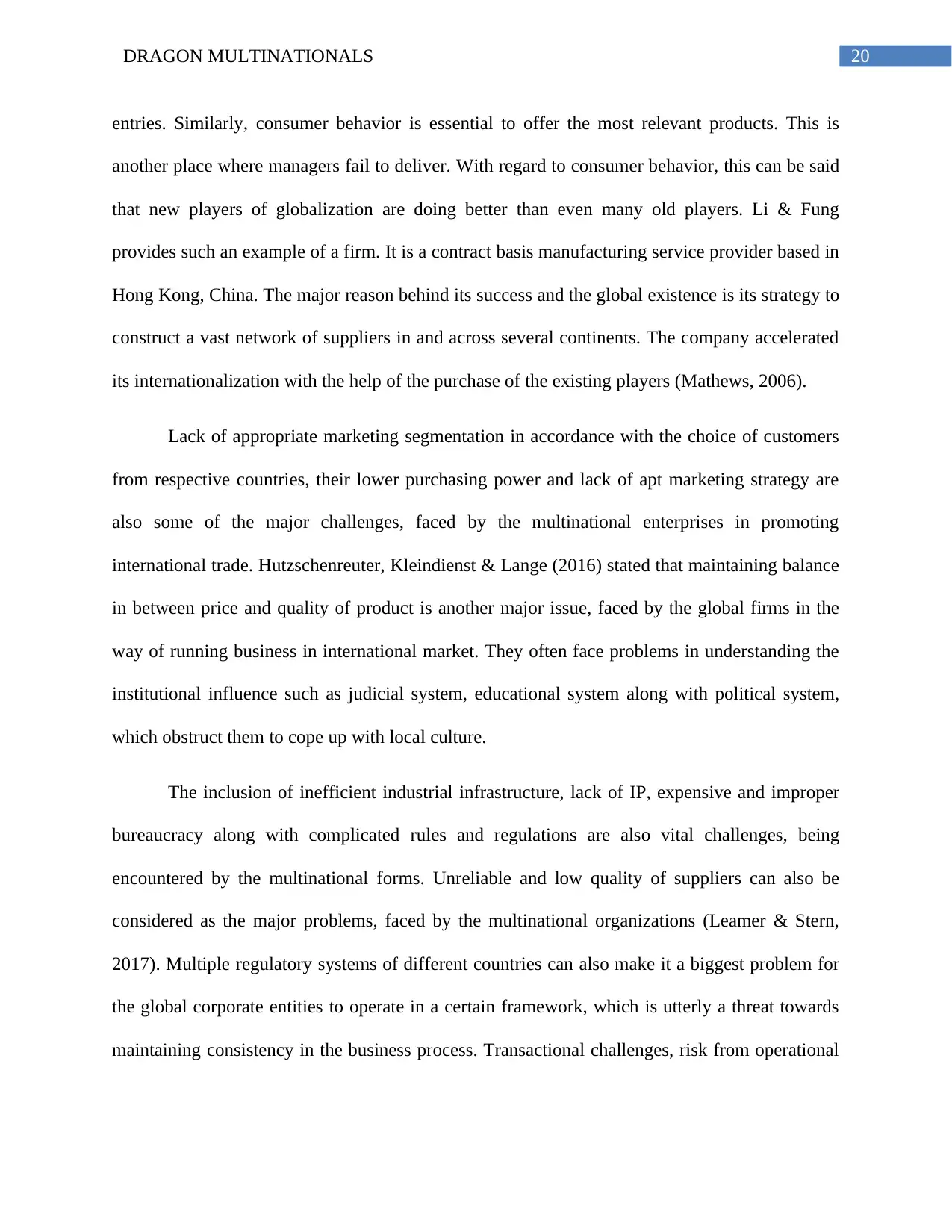
20DRAGON MULTINATIONALS
entries. Similarly, consumer behavior is essential to offer the most relevant products. This is
another place where managers fail to deliver. With regard to consumer behavior, this can be said
that new players of globalization are doing better than even many old players. Li & Fung
provides such an example of a firm. It is a contract basis manufacturing service provider based in
Hong Kong, China. The major reason behind its success and the global existence is its strategy to
construct a vast network of suppliers in and across several continents. The company accelerated
its internationalization with the help of the purchase of the existing players (Mathews, 2006).
Lack of appropriate marketing segmentation in accordance with the choice of customers
from respective countries, their lower purchasing power and lack of apt marketing strategy are
also some of the major challenges, faced by the multinational enterprises in promoting
international trade. Hutzschenreuter, Kleindienst & Lange (2016) stated that maintaining balance
in between price and quality of product is another major issue, faced by the global firms in the
way of running business in international market. They often face problems in understanding the
institutional influence such as judicial system, educational system along with political system,
which obstruct them to cope up with local culture.
The inclusion of inefficient industrial infrastructure, lack of IP, expensive and improper
bureaucracy along with complicated rules and regulations are also vital challenges, being
encountered by the multinational forms. Unreliable and low quality of suppliers can also be
considered as the major problems, faced by the multinational organizations (Leamer & Stern,
2017). Multiple regulatory systems of different countries can also make it a biggest problem for
the global corporate entities to operate in a certain framework, which is utterly a threat towards
maintaining consistency in the business process. Transactional challenges, risk from operational
entries. Similarly, consumer behavior is essential to offer the most relevant products. This is
another place where managers fail to deliver. With regard to consumer behavior, this can be said
that new players of globalization are doing better than even many old players. Li & Fung
provides such an example of a firm. It is a contract basis manufacturing service provider based in
Hong Kong, China. The major reason behind its success and the global existence is its strategy to
construct a vast network of suppliers in and across several continents. The company accelerated
its internationalization with the help of the purchase of the existing players (Mathews, 2006).
Lack of appropriate marketing segmentation in accordance with the choice of customers
from respective countries, their lower purchasing power and lack of apt marketing strategy are
also some of the major challenges, faced by the multinational enterprises in promoting
international trade. Hutzschenreuter, Kleindienst & Lange (2016) stated that maintaining balance
in between price and quality of product is another major issue, faced by the global firms in the
way of running business in international market. They often face problems in understanding the
institutional influence such as judicial system, educational system along with political system,
which obstruct them to cope up with local culture.
The inclusion of inefficient industrial infrastructure, lack of IP, expensive and improper
bureaucracy along with complicated rules and regulations are also vital challenges, being
encountered by the multinational forms. Unreliable and low quality of suppliers can also be
considered as the major problems, faced by the multinational organizations (Leamer & Stern,
2017). Multiple regulatory systems of different countries can also make it a biggest problem for
the global corporate entities to operate in a certain framework, which is utterly a threat towards
maintaining consistency in the business process. Transactional challenges, risk from operational
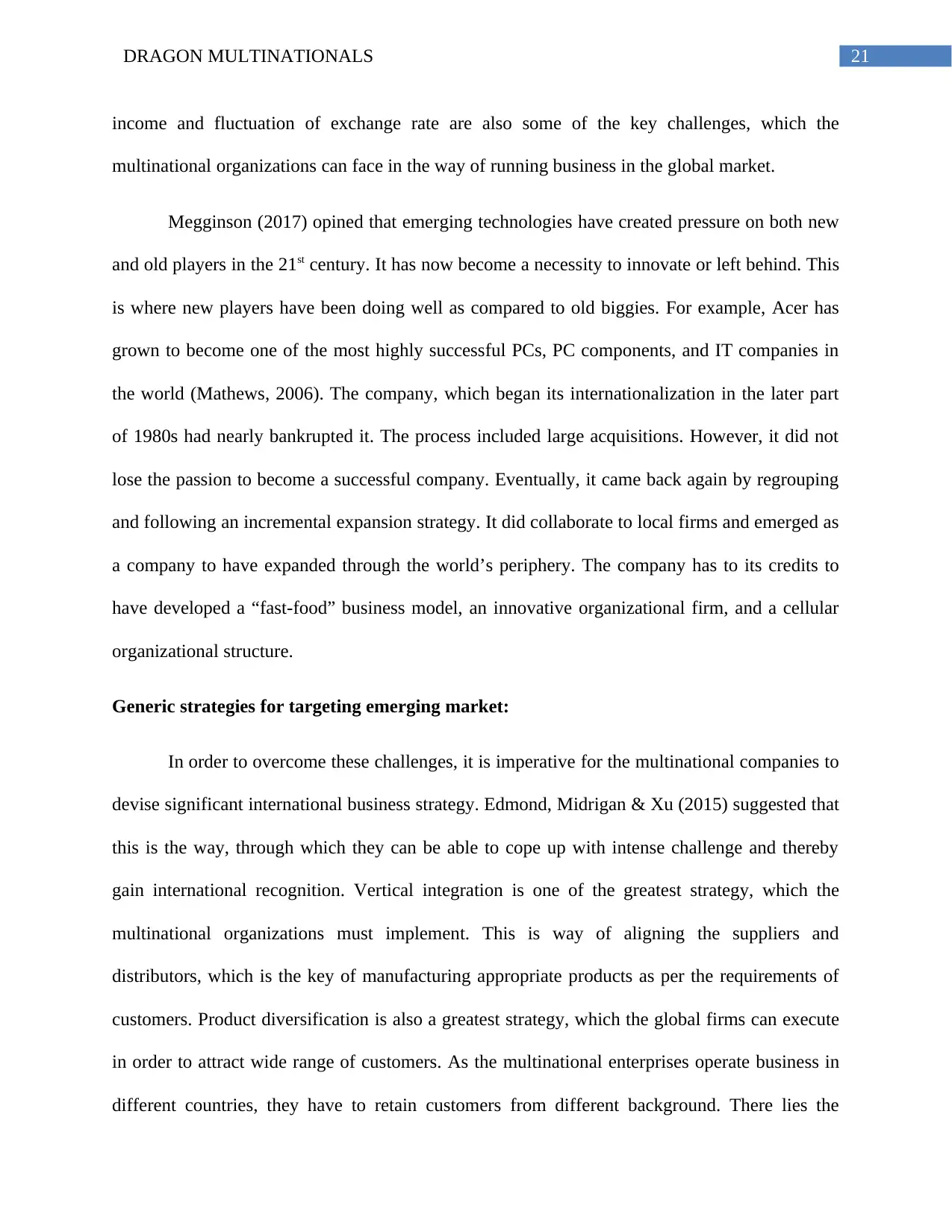
21DRAGON MULTINATIONALS
income and fluctuation of exchange rate are also some of the key challenges, which the
multinational organizations can face in the way of running business in the global market.
Megginson (2017) opined that emerging technologies have created pressure on both new
and old players in the 21st century. It has now become a necessity to innovate or left behind. This
is where new players have been doing well as compared to old biggies. For example, Acer has
grown to become one of the most highly successful PCs, PC components, and IT companies in
the world (Mathews, 2006). The company, which began its internationalization in the later part
of 1980s had nearly bankrupted it. The process included large acquisitions. However, it did not
lose the passion to become a successful company. Eventually, it came back again by regrouping
and following an incremental expansion strategy. It did collaborate to local firms and emerged as
a company to have expanded through the world’s periphery. The company has to its credits to
have developed a “fast-food” business model, an innovative organizational firm, and a cellular
organizational structure.
Generic strategies for targeting emerging market:
In order to overcome these challenges, it is imperative for the multinational companies to
devise significant international business strategy. Edmond, Midrigan & Xu (2015) suggested that
this is the way, through which they can be able to cope up with intense challenge and thereby
gain international recognition. Vertical integration is one of the greatest strategy, which the
multinational organizations must implement. This is way of aligning the suppliers and
distributors, which is the key of manufacturing appropriate products as per the requirements of
customers. Product diversification is also a greatest strategy, which the global firms can execute
in order to attract wide range of customers. As the multinational enterprises operate business in
different countries, they have to retain customers from different background. There lies the
income and fluctuation of exchange rate are also some of the key challenges, which the
multinational organizations can face in the way of running business in the global market.
Megginson (2017) opined that emerging technologies have created pressure on both new
and old players in the 21st century. It has now become a necessity to innovate or left behind. This
is where new players have been doing well as compared to old biggies. For example, Acer has
grown to become one of the most highly successful PCs, PC components, and IT companies in
the world (Mathews, 2006). The company, which began its internationalization in the later part
of 1980s had nearly bankrupted it. The process included large acquisitions. However, it did not
lose the passion to become a successful company. Eventually, it came back again by regrouping
and following an incremental expansion strategy. It did collaborate to local firms and emerged as
a company to have expanded through the world’s periphery. The company has to its credits to
have developed a “fast-food” business model, an innovative organizational firm, and a cellular
organizational structure.
Generic strategies for targeting emerging market:
In order to overcome these challenges, it is imperative for the multinational companies to
devise significant international business strategy. Edmond, Midrigan & Xu (2015) suggested that
this is the way, through which they can be able to cope up with intense challenge and thereby
gain international recognition. Vertical integration is one of the greatest strategy, which the
multinational organizations must implement. This is way of aligning the suppliers and
distributors, which is the key of manufacturing appropriate products as per the requirements of
customers. Product diversification is also a greatest strategy, which the global firms can execute
in order to attract wide range of customers. As the multinational enterprises operate business in
different countries, they have to retain customers from different background. There lies the
Secure Best Marks with AI Grader
Need help grading? Try our AI Grader for instant feedback on your assignments.
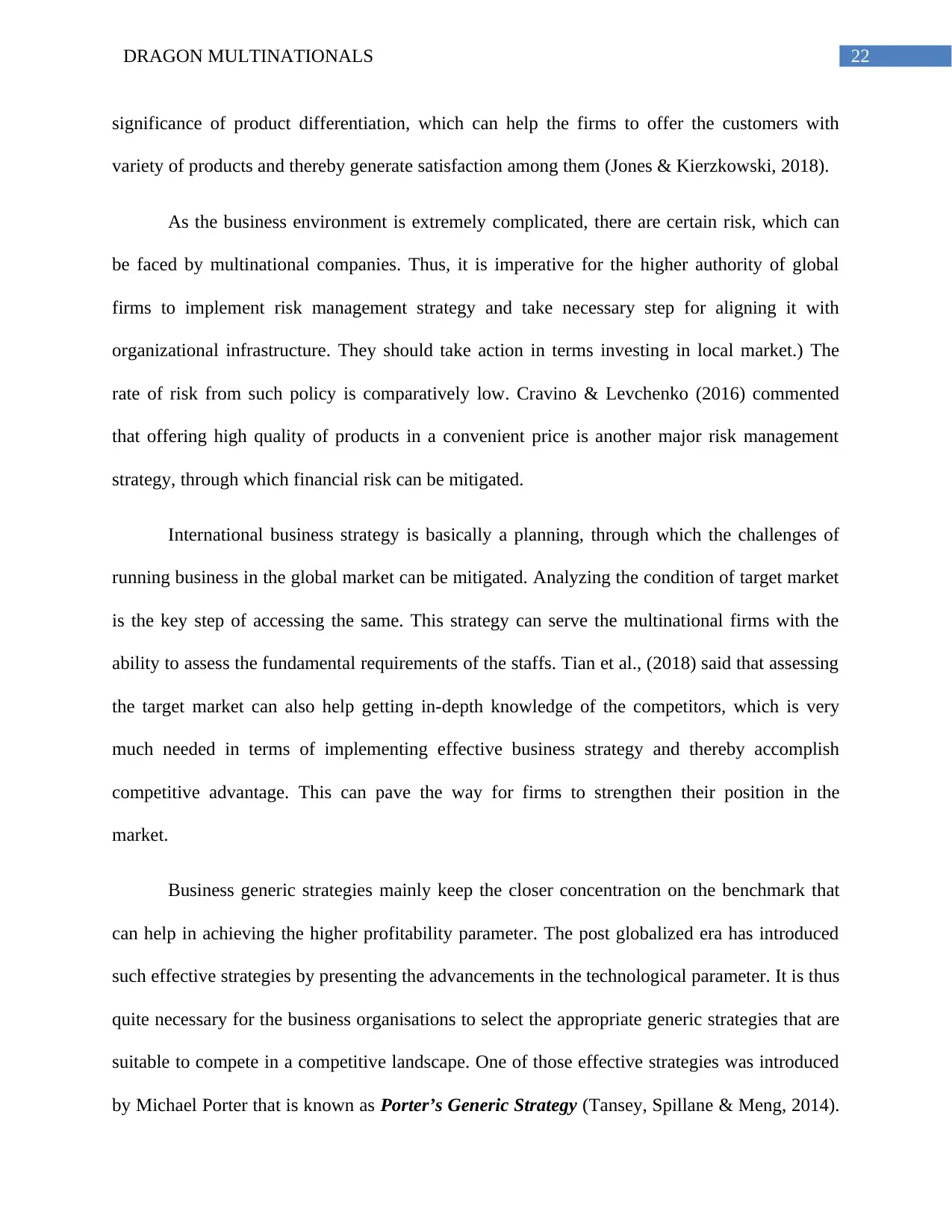
22DRAGON MULTINATIONALS
significance of product differentiation, which can help the firms to offer the customers with
variety of products and thereby generate satisfaction among them (Jones & Kierzkowski, 2018).
As the business environment is extremely complicated, there are certain risk, which can
be faced by multinational companies. Thus, it is imperative for the higher authority of global
firms to implement risk management strategy and take necessary step for aligning it with
organizational infrastructure. They should take action in terms investing in local market.) The
rate of risk from such policy is comparatively low. Cravino & Levchenko (2016) commented
that offering high quality of products in a convenient price is another major risk management
strategy, through which financial risk can be mitigated.
International business strategy is basically a planning, through which the challenges of
running business in the global market can be mitigated. Analyzing the condition of target market
is the key step of accessing the same. This strategy can serve the multinational firms with the
ability to assess the fundamental requirements of the staffs. Tian et al., (2018) said that assessing
the target market can also help getting in-depth knowledge of the competitors, which is very
much needed in terms of implementing effective business strategy and thereby accomplish
competitive advantage. This can pave the way for firms to strengthen their position in the
market.
Business generic strategies mainly keep the closer concentration on the benchmark that
can help in achieving the higher profitability parameter. The post globalized era has introduced
such effective strategies by presenting the advancements in the technological parameter. It is thus
quite necessary for the business organisations to select the appropriate generic strategies that are
suitable to compete in a competitive landscape. One of those effective strategies was introduced
by Michael Porter that is known as Porter’s Generic Strategy (Tansey, Spillane & Meng, 2014).
significance of product differentiation, which can help the firms to offer the customers with
variety of products and thereby generate satisfaction among them (Jones & Kierzkowski, 2018).
As the business environment is extremely complicated, there are certain risk, which can
be faced by multinational companies. Thus, it is imperative for the higher authority of global
firms to implement risk management strategy and take necessary step for aligning it with
organizational infrastructure. They should take action in terms investing in local market.) The
rate of risk from such policy is comparatively low. Cravino & Levchenko (2016) commented
that offering high quality of products in a convenient price is another major risk management
strategy, through which financial risk can be mitigated.
International business strategy is basically a planning, through which the challenges of
running business in the global market can be mitigated. Analyzing the condition of target market
is the key step of accessing the same. This strategy can serve the multinational firms with the
ability to assess the fundamental requirements of the staffs. Tian et al., (2018) said that assessing
the target market can also help getting in-depth knowledge of the competitors, which is very
much needed in terms of implementing effective business strategy and thereby accomplish
competitive advantage. This can pave the way for firms to strengthen their position in the
market.
Business generic strategies mainly keep the closer concentration on the benchmark that
can help in achieving the higher profitability parameter. The post globalized era has introduced
such effective strategies by presenting the advancements in the technological parameter. It is thus
quite necessary for the business organisations to select the appropriate generic strategies that are
suitable to compete in a competitive landscape. One of those effective strategies was introduced
by Michael Porter that is known as Porter’s Generic Strategy (Tansey, Spillane & Meng, 2014).
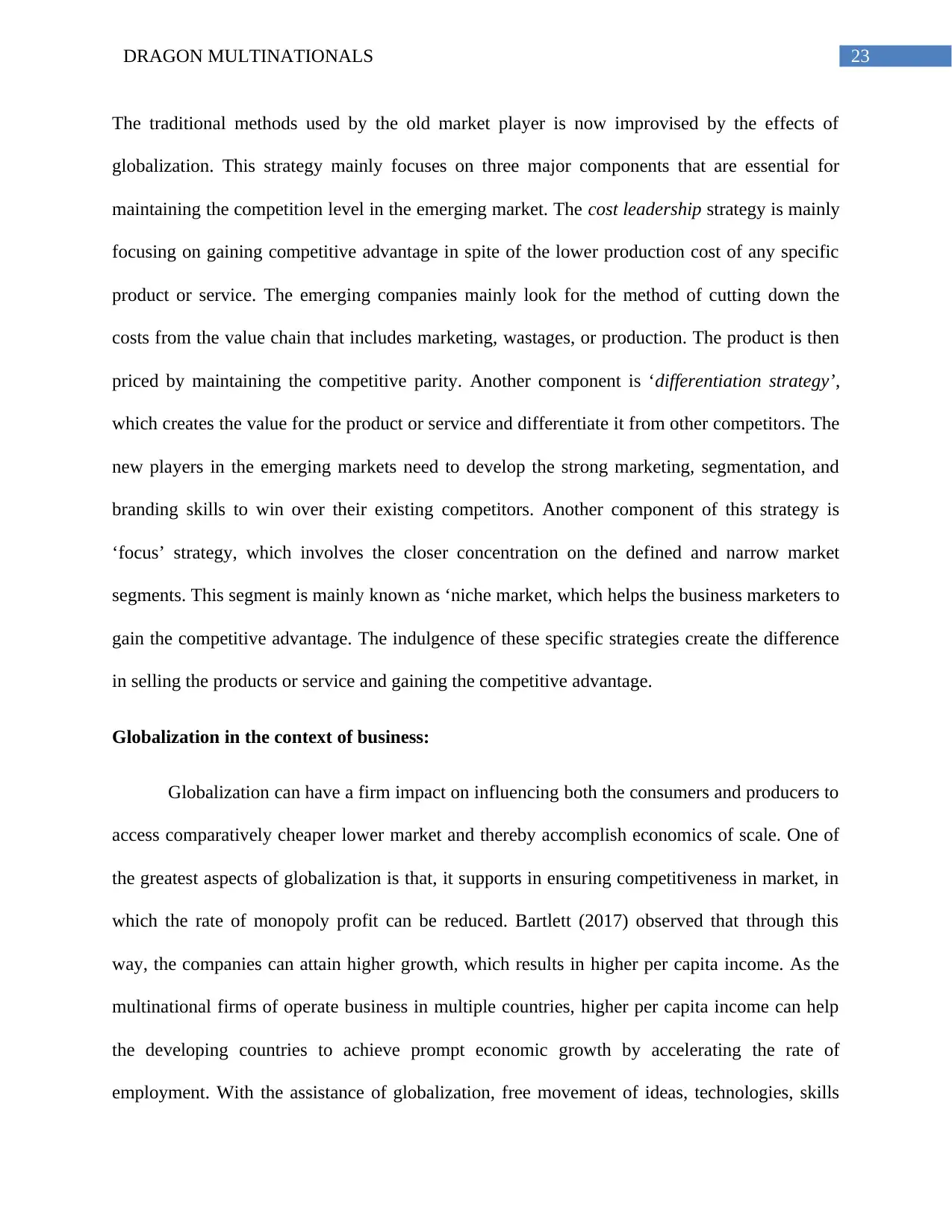
23DRAGON MULTINATIONALS
The traditional methods used by the old market player is now improvised by the effects of
globalization. This strategy mainly focuses on three major components that are essential for
maintaining the competition level in the emerging market. The cost leadership strategy is mainly
focusing on gaining competitive advantage in spite of the lower production cost of any specific
product or service. The emerging companies mainly look for the method of cutting down the
costs from the value chain that includes marketing, wastages, or production. The product is then
priced by maintaining the competitive parity. Another component is ‘differentiation strategy’,
which creates the value for the product or service and differentiate it from other competitors. The
new players in the emerging markets need to develop the strong marketing, segmentation, and
branding skills to win over their existing competitors. Another component of this strategy is
‘focus’ strategy, which involves the closer concentration on the defined and narrow market
segments. This segment is mainly known as ‘niche market, which helps the business marketers to
gain the competitive advantage. The indulgence of these specific strategies create the difference
in selling the products or service and gaining the competitive advantage.
Globalization in the context of business:
Globalization can have a firm impact on influencing both the consumers and producers to
access comparatively cheaper lower market and thereby accomplish economics of scale. One of
the greatest aspects of globalization is that, it supports in ensuring competitiveness in market, in
which the rate of monopoly profit can be reduced. Bartlett (2017) observed that through this
way, the companies can attain higher growth, which results in higher per capita income. As the
multinational firms of operate business in multiple countries, higher per capita income can help
the developing countries to achieve prompt economic growth by accelerating the rate of
employment. With the assistance of globalization, free movement of ideas, technologies, skills
The traditional methods used by the old market player is now improvised by the effects of
globalization. This strategy mainly focuses on three major components that are essential for
maintaining the competition level in the emerging market. The cost leadership strategy is mainly
focusing on gaining competitive advantage in spite of the lower production cost of any specific
product or service. The emerging companies mainly look for the method of cutting down the
costs from the value chain that includes marketing, wastages, or production. The product is then
priced by maintaining the competitive parity. Another component is ‘differentiation strategy’,
which creates the value for the product or service and differentiate it from other competitors. The
new players in the emerging markets need to develop the strong marketing, segmentation, and
branding skills to win over their existing competitors. Another component of this strategy is
‘focus’ strategy, which involves the closer concentration on the defined and narrow market
segments. This segment is mainly known as ‘niche market, which helps the business marketers to
gain the competitive advantage. The indulgence of these specific strategies create the difference
in selling the products or service and gaining the competitive advantage.
Globalization in the context of business:
Globalization can have a firm impact on influencing both the consumers and producers to
access comparatively cheaper lower market and thereby accomplish economics of scale. One of
the greatest aspects of globalization is that, it supports in ensuring competitiveness in market, in
which the rate of monopoly profit can be reduced. Bartlett (2017) observed that through this
way, the companies can attain higher growth, which results in higher per capita income. As the
multinational firms of operate business in multiple countries, higher per capita income can help
the developing countries to achieve prompt economic growth by accelerating the rate of
employment. With the assistance of globalization, free movement of ideas, technologies, skills
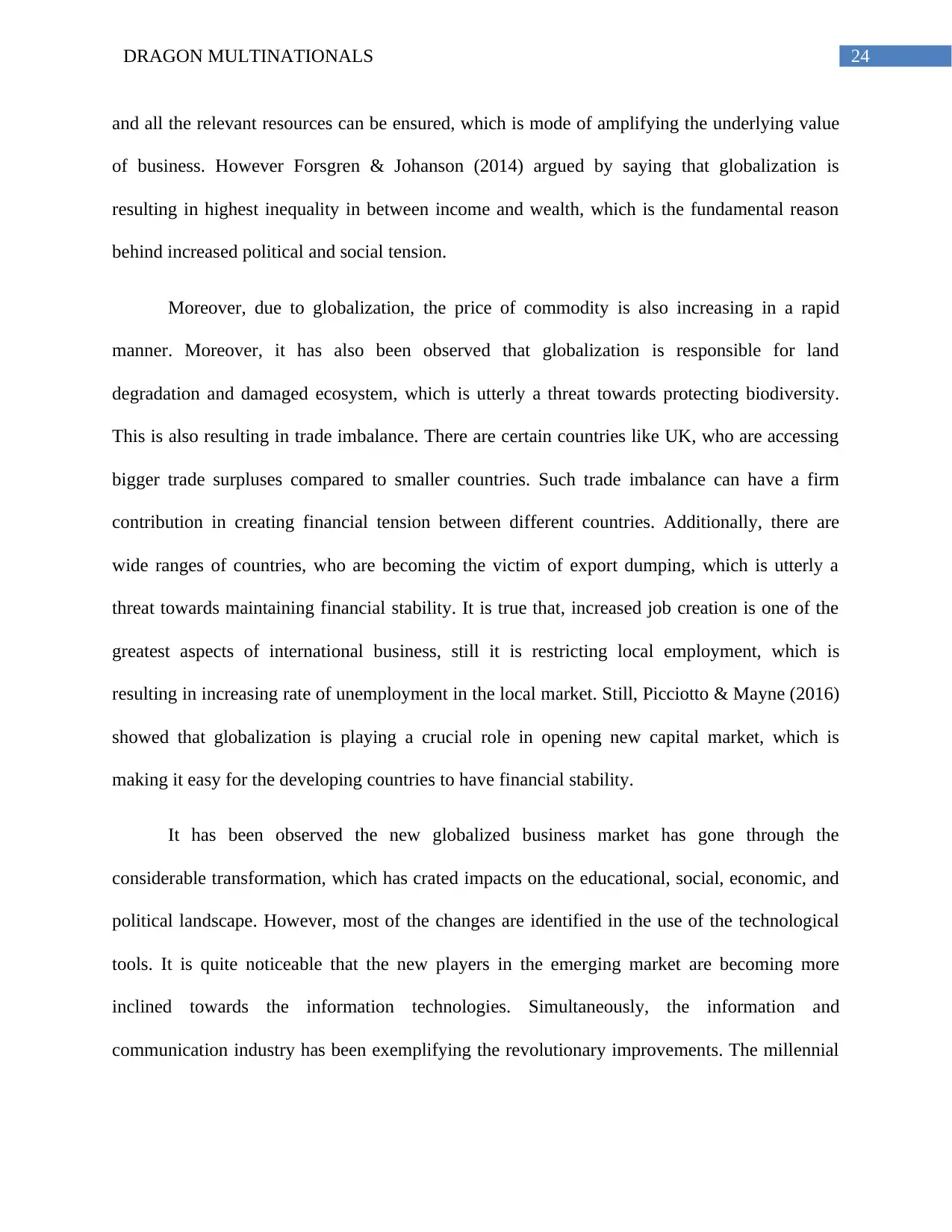
24DRAGON MULTINATIONALS
and all the relevant resources can be ensured, which is mode of amplifying the underlying value
of business. However Forsgren & Johanson (2014) argued by saying that globalization is
resulting in highest inequality in between income and wealth, which is the fundamental reason
behind increased political and social tension.
Moreover, due to globalization, the price of commodity is also increasing in a rapid
manner. Moreover, it has also been observed that globalization is responsible for land
degradation and damaged ecosystem, which is utterly a threat towards protecting biodiversity.
This is also resulting in trade imbalance. There are certain countries like UK, who are accessing
bigger trade surpluses compared to smaller countries. Such trade imbalance can have a firm
contribution in creating financial tension between different countries. Additionally, there are
wide ranges of countries, who are becoming the victim of export dumping, which is utterly a
threat towards maintaining financial stability. It is true that, increased job creation is one of the
greatest aspects of international business, still it is restricting local employment, which is
resulting in increasing rate of unemployment in the local market. Still, Picciotto & Mayne (2016)
showed that globalization is playing a crucial role in opening new capital market, which is
making it easy for the developing countries to have financial stability.
It has been observed the new globalized business market has gone through the
considerable transformation, which has crated impacts on the educational, social, economic, and
political landscape. However, most of the changes are identified in the use of the technological
tools. It is quite noticeable that the new players in the emerging market are becoming more
inclined towards the information technologies. Simultaneously, the information and
communication industry has been exemplifying the revolutionary improvements. The millennial
and all the relevant resources can be ensured, which is mode of amplifying the underlying value
of business. However Forsgren & Johanson (2014) argued by saying that globalization is
resulting in highest inequality in between income and wealth, which is the fundamental reason
behind increased political and social tension.
Moreover, due to globalization, the price of commodity is also increasing in a rapid
manner. Moreover, it has also been observed that globalization is responsible for land
degradation and damaged ecosystem, which is utterly a threat towards protecting biodiversity.
This is also resulting in trade imbalance. There are certain countries like UK, who are accessing
bigger trade surpluses compared to smaller countries. Such trade imbalance can have a firm
contribution in creating financial tension between different countries. Additionally, there are
wide ranges of countries, who are becoming the victim of export dumping, which is utterly a
threat towards maintaining financial stability. It is true that, increased job creation is one of the
greatest aspects of international business, still it is restricting local employment, which is
resulting in increasing rate of unemployment in the local market. Still, Picciotto & Mayne (2016)
showed that globalization is playing a crucial role in opening new capital market, which is
making it easy for the developing countries to have financial stability.
It has been observed the new globalized business market has gone through the
considerable transformation, which has crated impacts on the educational, social, economic, and
political landscape. However, most of the changes are identified in the use of the technological
tools. It is quite noticeable that the new players in the emerging market are becoming more
inclined towards the information technologies. Simultaneously, the information and
communication industry has been exemplifying the revolutionary improvements. The millennial
Paraphrase This Document
Need a fresh take? Get an instant paraphrase of this document with our AI Paraphraser
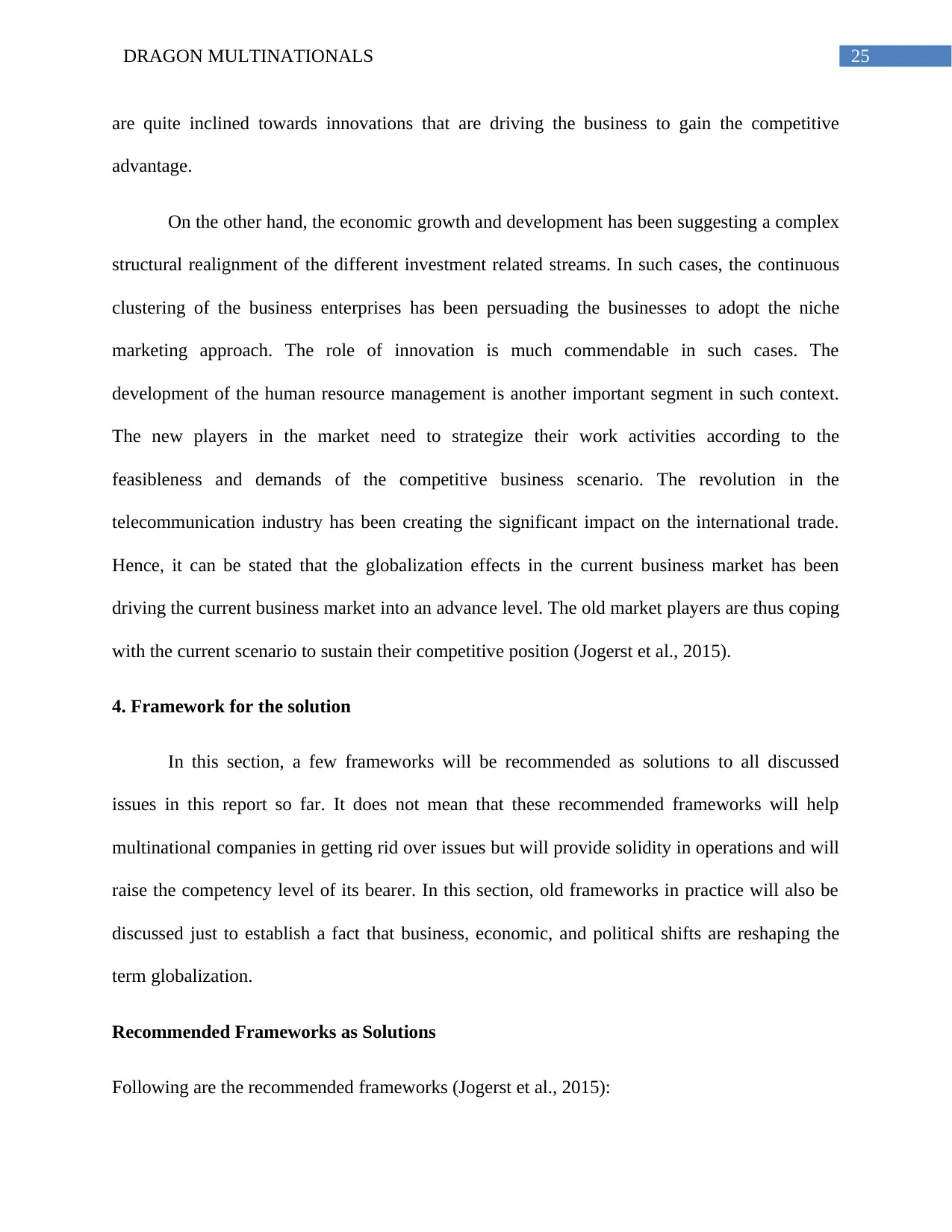
25DRAGON MULTINATIONALS
are quite inclined towards innovations that are driving the business to gain the competitive
advantage.
On the other hand, the economic growth and development has been suggesting a complex
structural realignment of the different investment related streams. In such cases, the continuous
clustering of the business enterprises has been persuading the businesses to adopt the niche
marketing approach. The role of innovation is much commendable in such cases. The
development of the human resource management is another important segment in such context.
The new players in the market need to strategize their work activities according to the
feasibleness and demands of the competitive business scenario. The revolution in the
telecommunication industry has been creating the significant impact on the international trade.
Hence, it can be stated that the globalization effects in the current business market has been
driving the current business market into an advance level. The old market players are thus coping
with the current scenario to sustain their competitive position (Jogerst et al., 2015).
4. Framework for the solution
In this section, a few frameworks will be recommended as solutions to all discussed
issues in this report so far. It does not mean that these recommended frameworks will help
multinational companies in getting rid over issues but will provide solidity in operations and will
raise the competency level of its bearer. In this section, old frameworks in practice will also be
discussed just to establish a fact that business, economic, and political shifts are reshaping the
term globalization.
Recommended Frameworks as Solutions
Following are the recommended frameworks (Jogerst et al., 2015):
are quite inclined towards innovations that are driving the business to gain the competitive
advantage.
On the other hand, the economic growth and development has been suggesting a complex
structural realignment of the different investment related streams. In such cases, the continuous
clustering of the business enterprises has been persuading the businesses to adopt the niche
marketing approach. The role of innovation is much commendable in such cases. The
development of the human resource management is another important segment in such context.
The new players in the market need to strategize their work activities according to the
feasibleness and demands of the competitive business scenario. The revolution in the
telecommunication industry has been creating the significant impact on the international trade.
Hence, it can be stated that the globalization effects in the current business market has been
driving the current business market into an advance level. The old market players are thus coping
with the current scenario to sustain their competitive position (Jogerst et al., 2015).
4. Framework for the solution
In this section, a few frameworks will be recommended as solutions to all discussed
issues in this report so far. It does not mean that these recommended frameworks will help
multinational companies in getting rid over issues but will provide solidity in operations and will
raise the competency level of its bearer. In this section, old frameworks in practice will also be
discussed just to establish a fact that business, economic, and political shifts are reshaping the
term globalization.
Recommended Frameworks as Solutions
Following are the recommended frameworks (Jogerst et al., 2015):
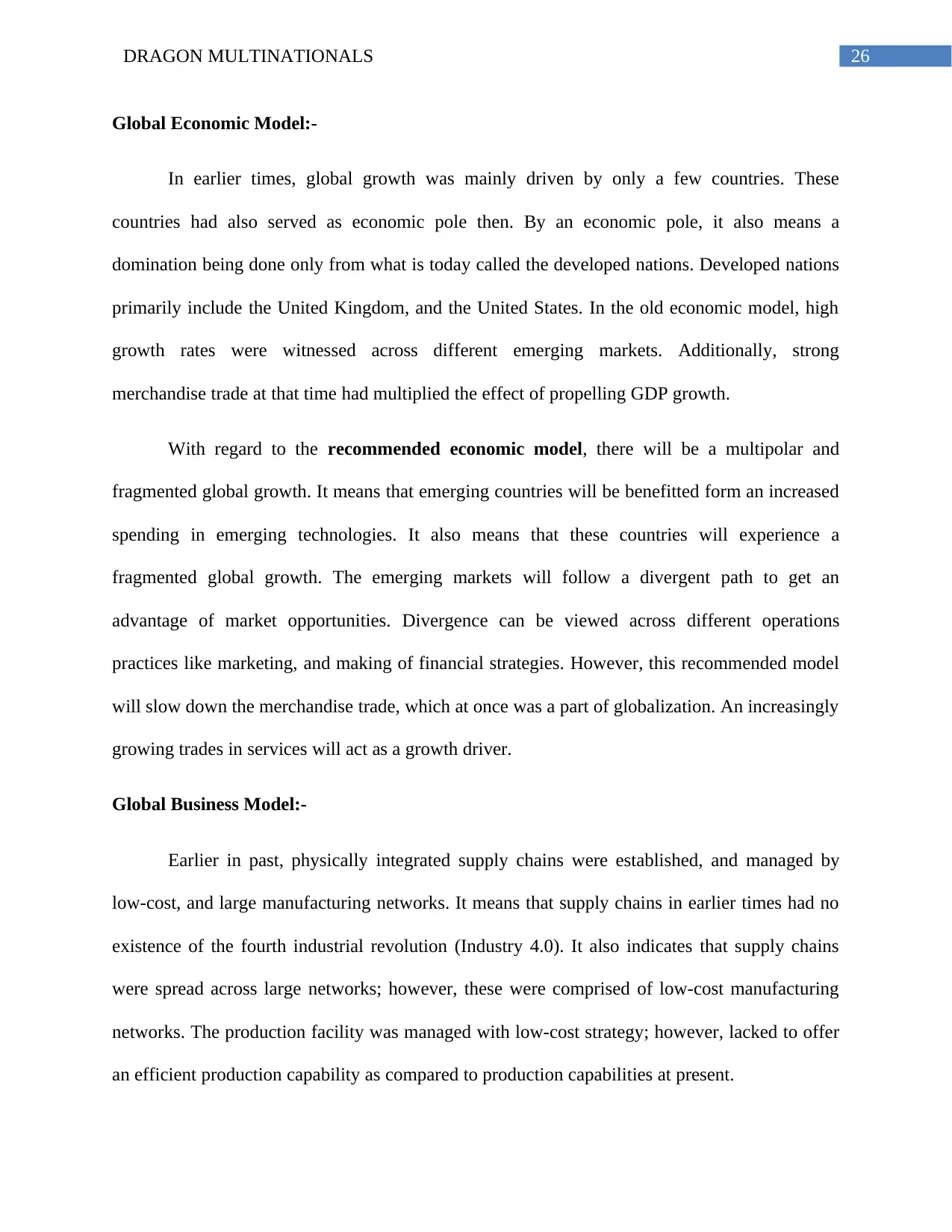
26DRAGON MULTINATIONALS
Global Economic Model:-
In earlier times, global growth was mainly driven by only a few countries. These
countries had also served as economic pole then. By an economic pole, it also means a
domination being done only from what is today called the developed nations. Developed nations
primarily include the United Kingdom, and the United States. In the old economic model, high
growth rates were witnessed across different emerging markets. Additionally, strong
merchandise trade at that time had multiplied the effect of propelling GDP growth.
With regard to the recommended economic model, there will be a multipolar and
fragmented global growth. It means that emerging countries will be benefitted form an increased
spending in emerging technologies. It also means that these countries will experience a
fragmented global growth. The emerging markets will follow a divergent path to get an
advantage of market opportunities. Divergence can be viewed across different operations
practices like marketing, and making of financial strategies. However, this recommended model
will slow down the merchandise trade, which at once was a part of globalization. An increasingly
growing trades in services will act as a growth driver.
Global Business Model:-
Earlier in past, physically integrated supply chains were established, and managed by
low-cost, and large manufacturing networks. It means that supply chains in earlier times had no
existence of the fourth industrial revolution (Industry 4.0). It also indicates that supply chains
were spread across large networks; however, these were comprised of low-cost manufacturing
networks. The production facility was managed with low-cost strategy; however, lacked to offer
an efficient production capability as compared to production capabilities at present.
Global Economic Model:-
In earlier times, global growth was mainly driven by only a few countries. These
countries had also served as economic pole then. By an economic pole, it also means a
domination being done only from what is today called the developed nations. Developed nations
primarily include the United Kingdom, and the United States. In the old economic model, high
growth rates were witnessed across different emerging markets. Additionally, strong
merchandise trade at that time had multiplied the effect of propelling GDP growth.
With regard to the recommended economic model, there will be a multipolar and
fragmented global growth. It means that emerging countries will be benefitted form an increased
spending in emerging technologies. It also means that these countries will experience a
fragmented global growth. The emerging markets will follow a divergent path to get an
advantage of market opportunities. Divergence can be viewed across different operations
practices like marketing, and making of financial strategies. However, this recommended model
will slow down the merchandise trade, which at once was a part of globalization. An increasingly
growing trades in services will act as a growth driver.
Global Business Model:-
Earlier in past, physically integrated supply chains were established, and managed by
low-cost, and large manufacturing networks. It means that supply chains in earlier times had no
existence of the fourth industrial revolution (Industry 4.0). It also indicates that supply chains
were spread across large networks; however, these were comprised of low-cost manufacturing
networks. The production facility was managed with low-cost strategy; however, lacked to offer
an efficient production capability as compared to production capabilities at present.
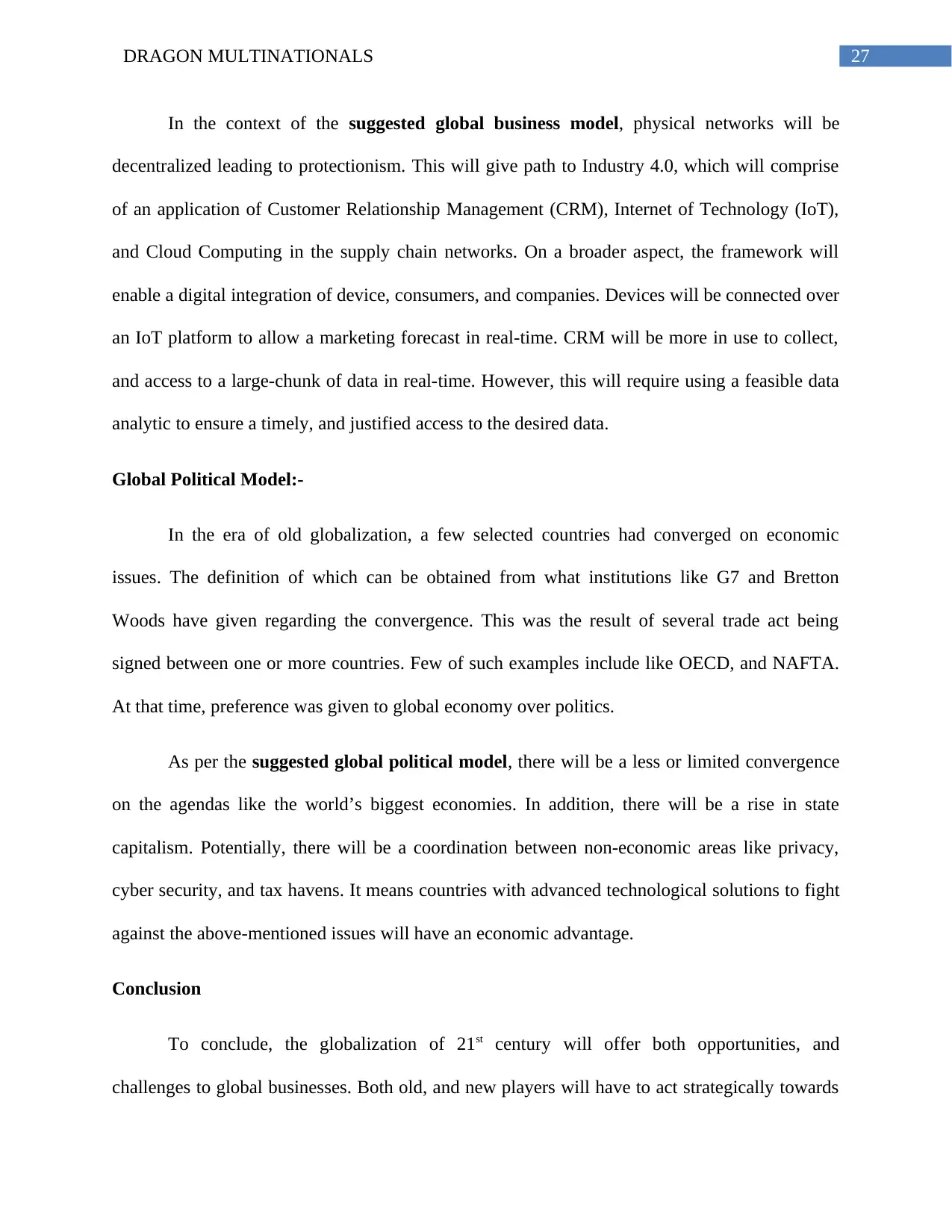
27DRAGON MULTINATIONALS
In the context of the suggested global business model, physical networks will be
decentralized leading to protectionism. This will give path to Industry 4.0, which will comprise
of an application of Customer Relationship Management (CRM), Internet of Technology (IoT),
and Cloud Computing in the supply chain networks. On a broader aspect, the framework will
enable a digital integration of device, consumers, and companies. Devices will be connected over
an IoT platform to allow a marketing forecast in real-time. CRM will be more in use to collect,
and access to a large-chunk of data in real-time. However, this will require using a feasible data
analytic to ensure a timely, and justified access to the desired data.
Global Political Model:-
In the era of old globalization, a few selected countries had converged on economic
issues. The definition of which can be obtained from what institutions like G7 and Bretton
Woods have given regarding the convergence. This was the result of several trade act being
signed between one or more countries. Few of such examples include like OECD, and NAFTA.
At that time, preference was given to global economy over politics.
As per the suggested global political model, there will be a less or limited convergence
on the agendas like the world’s biggest economies. In addition, there will be a rise in state
capitalism. Potentially, there will be a coordination between non-economic areas like privacy,
cyber security, and tax havens. It means countries with advanced technological solutions to fight
against the above-mentioned issues will have an economic advantage.
Conclusion
To conclude, the globalization of 21st century will offer both opportunities, and
challenges to global businesses. Both old, and new players will have to act strategically towards
In the context of the suggested global business model, physical networks will be
decentralized leading to protectionism. This will give path to Industry 4.0, which will comprise
of an application of Customer Relationship Management (CRM), Internet of Technology (IoT),
and Cloud Computing in the supply chain networks. On a broader aspect, the framework will
enable a digital integration of device, consumers, and companies. Devices will be connected over
an IoT platform to allow a marketing forecast in real-time. CRM will be more in use to collect,
and access to a large-chunk of data in real-time. However, this will require using a feasible data
analytic to ensure a timely, and justified access to the desired data.
Global Political Model:-
In the era of old globalization, a few selected countries had converged on economic
issues. The definition of which can be obtained from what institutions like G7 and Bretton
Woods have given regarding the convergence. This was the result of several trade act being
signed between one or more countries. Few of such examples include like OECD, and NAFTA.
At that time, preference was given to global economy over politics.
As per the suggested global political model, there will be a less or limited convergence
on the agendas like the world’s biggest economies. In addition, there will be a rise in state
capitalism. Potentially, there will be a coordination between non-economic areas like privacy,
cyber security, and tax havens. It means countries with advanced technological solutions to fight
against the above-mentioned issues will have an economic advantage.
Conclusion
To conclude, the globalization of 21st century will offer both opportunities, and
challenges to global businesses. Both old, and new players will have to act strategically towards
Secure Best Marks with AI Grader
Need help grading? Try our AI Grader for instant feedback on your assignments.
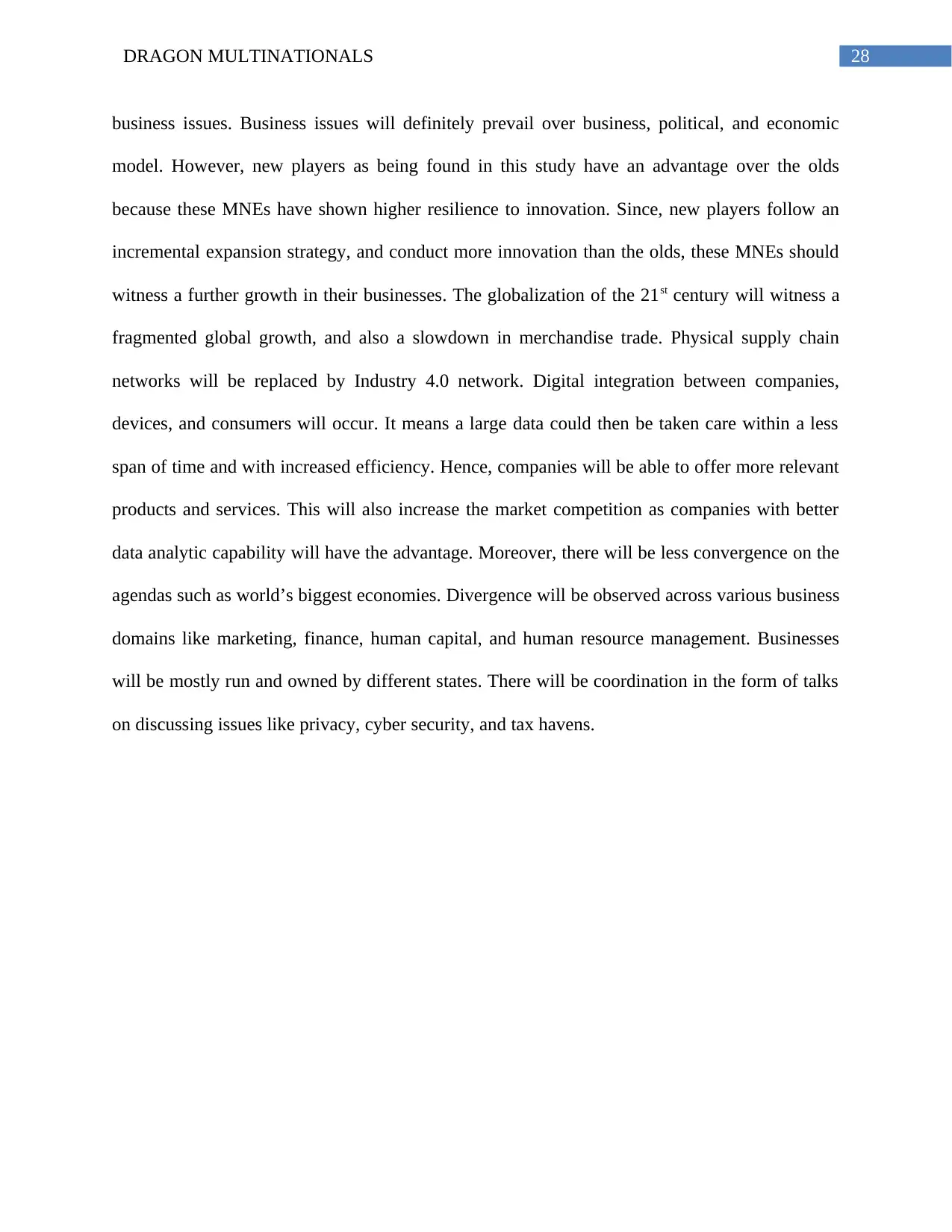
28DRAGON MULTINATIONALS
business issues. Business issues will definitely prevail over business, political, and economic
model. However, new players as being found in this study have an advantage over the olds
because these MNEs have shown higher resilience to innovation. Since, new players follow an
incremental expansion strategy, and conduct more innovation than the olds, these MNEs should
witness a further growth in their businesses. The globalization of the 21st century will witness a
fragmented global growth, and also a slowdown in merchandise trade. Physical supply chain
networks will be replaced by Industry 4.0 network. Digital integration between companies,
devices, and consumers will occur. It means a large data could then be taken care within a less
span of time and with increased efficiency. Hence, companies will be able to offer more relevant
products and services. This will also increase the market competition as companies with better
data analytic capability will have the advantage. Moreover, there will be less convergence on the
agendas such as world’s biggest economies. Divergence will be observed across various business
domains like marketing, finance, human capital, and human resource management. Businesses
will be mostly run and owned by different states. There will be coordination in the form of talks
on discussing issues like privacy, cyber security, and tax havens.
business issues. Business issues will definitely prevail over business, political, and economic
model. However, new players as being found in this study have an advantage over the olds
because these MNEs have shown higher resilience to innovation. Since, new players follow an
incremental expansion strategy, and conduct more innovation than the olds, these MNEs should
witness a further growth in their businesses. The globalization of the 21st century will witness a
fragmented global growth, and also a slowdown in merchandise trade. Physical supply chain
networks will be replaced by Industry 4.0 network. Digital integration between companies,
devices, and consumers will occur. It means a large data could then be taken care within a less
span of time and with increased efficiency. Hence, companies will be able to offer more relevant
products and services. This will also increase the market competition as companies with better
data analytic capability will have the advantage. Moreover, there will be less convergence on the
agendas such as world’s biggest economies. Divergence will be observed across various business
domains like marketing, finance, human capital, and human resource management. Businesses
will be mostly run and owned by different states. There will be coordination in the form of talks
on discussing issues like privacy, cyber security, and tax havens.
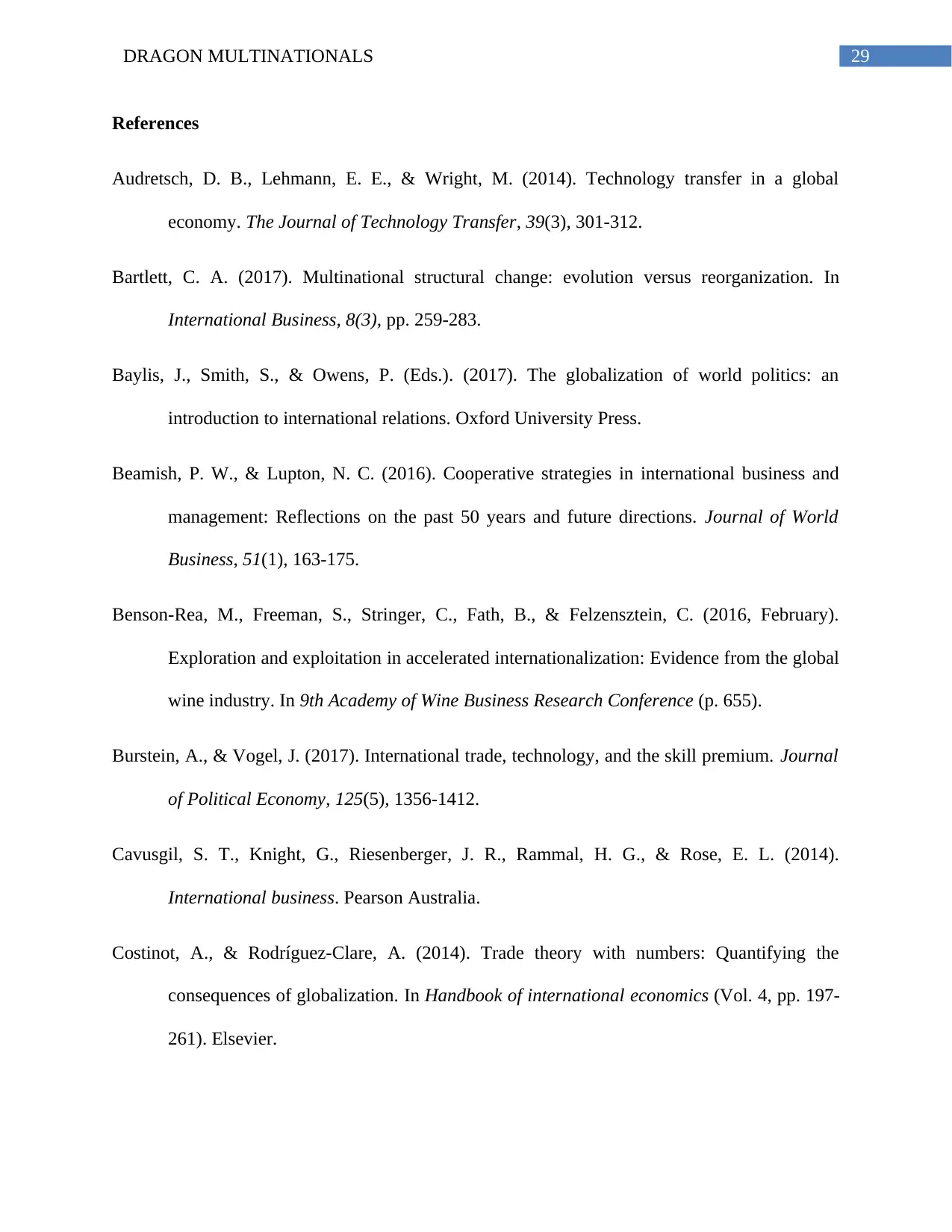
29DRAGON MULTINATIONALS
References
Audretsch, D. B., Lehmann, E. E., & Wright, M. (2014). Technology transfer in a global
economy. The Journal of Technology Transfer, 39(3), 301-312.
Bartlett, C. A. (2017). Multinational structural change: evolution versus reorganization. In
International Business, 8(3), pp. 259-283.
Baylis, J., Smith, S., & Owens, P. (Eds.). (2017). The globalization of world politics: an
introduction to international relations. Oxford University Press.
Beamish, P. W., & Lupton, N. C. (2016). Cooperative strategies in international business and
management: Reflections on the past 50 years and future directions. Journal of World
Business, 51(1), 163-175.
Benson-Rea, M., Freeman, S., Stringer, C., Fath, B., & Felzensztein, C. (2016, February).
Exploration and exploitation in accelerated internationalization: Evidence from the global
wine industry. In 9th Academy of Wine Business Research Conference (p. 655).
Burstein, A., & Vogel, J. (2017). International trade, technology, and the skill premium. Journal
of Political Economy, 125(5), 1356-1412.
Cavusgil, S. T., Knight, G., Riesenberger, J. R., Rammal, H. G., & Rose, E. L. (2014).
International business. Pearson Australia.
Costinot, A., & Rodríguez-Clare, A. (2014). Trade theory with numbers: Quantifying the
consequences of globalization. In Handbook of international economics (Vol. 4, pp. 197-
261). Elsevier.
References
Audretsch, D. B., Lehmann, E. E., & Wright, M. (2014). Technology transfer in a global
economy. The Journal of Technology Transfer, 39(3), 301-312.
Bartlett, C. A. (2017). Multinational structural change: evolution versus reorganization. In
International Business, 8(3), pp. 259-283.
Baylis, J., Smith, S., & Owens, P. (Eds.). (2017). The globalization of world politics: an
introduction to international relations. Oxford University Press.
Beamish, P. W., & Lupton, N. C. (2016). Cooperative strategies in international business and
management: Reflections on the past 50 years and future directions. Journal of World
Business, 51(1), 163-175.
Benson-Rea, M., Freeman, S., Stringer, C., Fath, B., & Felzensztein, C. (2016, February).
Exploration and exploitation in accelerated internationalization: Evidence from the global
wine industry. In 9th Academy of Wine Business Research Conference (p. 655).
Burstein, A., & Vogel, J. (2017). International trade, technology, and the skill premium. Journal
of Political Economy, 125(5), 1356-1412.
Cavusgil, S. T., Knight, G., Riesenberger, J. R., Rammal, H. G., & Rose, E. L. (2014).
International business. Pearson Australia.
Costinot, A., & Rodríguez-Clare, A. (2014). Trade theory with numbers: Quantifying the
consequences of globalization. In Handbook of international economics (Vol. 4, pp. 197-
261). Elsevier.
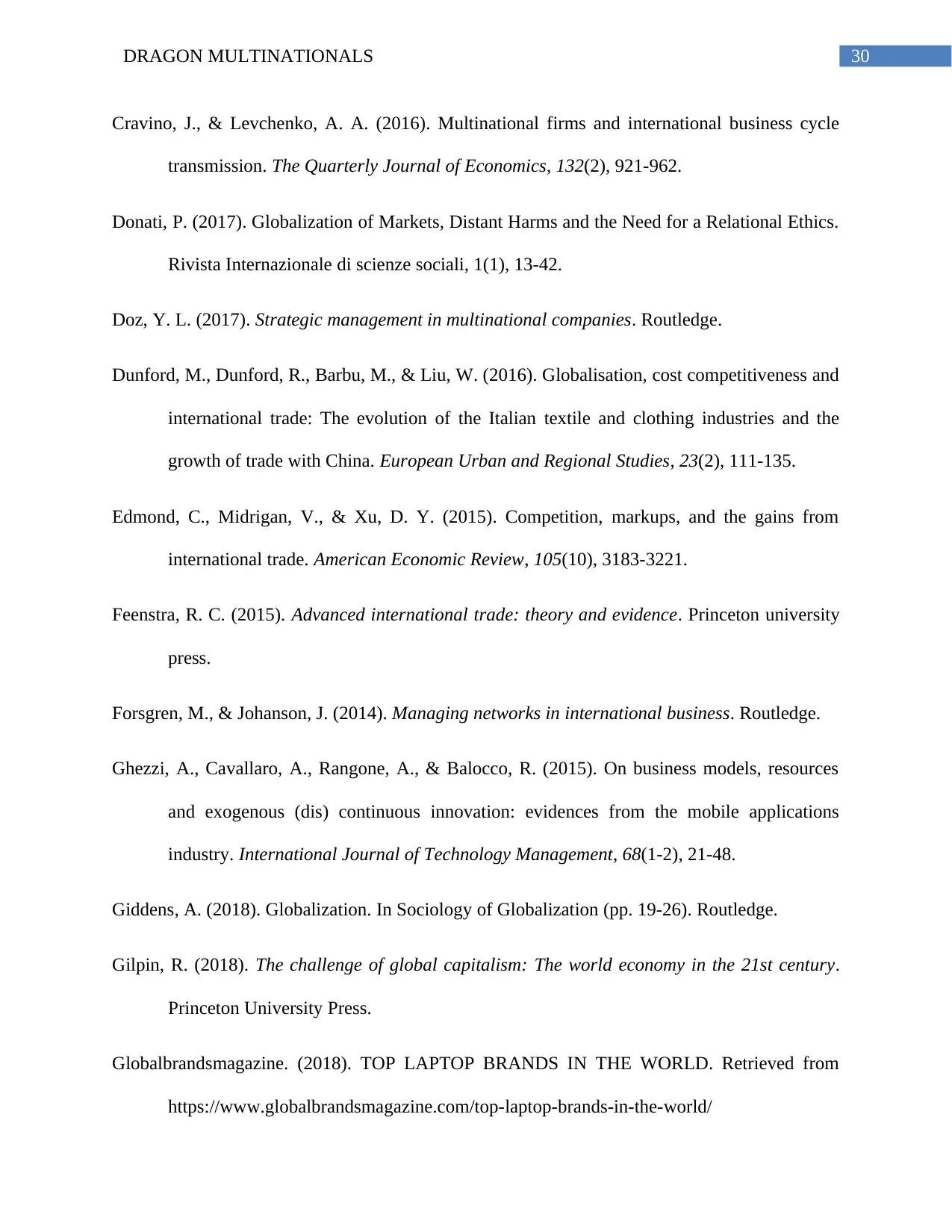
30DRAGON MULTINATIONALS
Cravino, J., & Levchenko, A. A. (2016). Multinational firms and international business cycle
transmission. The Quarterly Journal of Economics, 132(2), 921-962.
Donati, P. (2017). Globalization of Markets, Distant Harms and the Need for a Relational Ethics.
Rivista Internazionale di scienze sociali, 1(1), 13-42.
Doz, Y. L. (2017). Strategic management in multinational companies. Routledge.
Dunford, M., Dunford, R., Barbu, M., & Liu, W. (2016). Globalisation, cost competitiveness and
international trade: The evolution of the Italian textile and clothing industries and the
growth of trade with China. European Urban and Regional Studies, 23(2), 111-135.
Edmond, C., Midrigan, V., & Xu, D. Y. (2015). Competition, markups, and the gains from
international trade. American Economic Review, 105(10), 3183-3221.
Feenstra, R. C. (2015). Advanced international trade: theory and evidence. Princeton university
press.
Forsgren, M., & Johanson, J. (2014). Managing networks in international business. Routledge.
Ghezzi, A., Cavallaro, A., Rangone, A., & Balocco, R. (2015). On business models, resources
and exogenous (dis) continuous innovation: evidences from the mobile applications
industry. International Journal of Technology Management, 68(1-2), 21-48.
Giddens, A. (2018). Globalization. In Sociology of Globalization (pp. 19-26). Routledge.
Gilpin, R. (2018). The challenge of global capitalism: The world economy in the 21st century.
Princeton University Press.
Globalbrandsmagazine. (2018). TOP LAPTOP BRANDS IN THE WORLD. Retrieved from
https://www.globalbrandsmagazine.com/top-laptop-brands-in-the-world/
Cravino, J., & Levchenko, A. A. (2016). Multinational firms and international business cycle
transmission. The Quarterly Journal of Economics, 132(2), 921-962.
Donati, P. (2017). Globalization of Markets, Distant Harms and the Need for a Relational Ethics.
Rivista Internazionale di scienze sociali, 1(1), 13-42.
Doz, Y. L. (2017). Strategic management in multinational companies. Routledge.
Dunford, M., Dunford, R., Barbu, M., & Liu, W. (2016). Globalisation, cost competitiveness and
international trade: The evolution of the Italian textile and clothing industries and the
growth of trade with China. European Urban and Regional Studies, 23(2), 111-135.
Edmond, C., Midrigan, V., & Xu, D. Y. (2015). Competition, markups, and the gains from
international trade. American Economic Review, 105(10), 3183-3221.
Feenstra, R. C. (2015). Advanced international trade: theory and evidence. Princeton university
press.
Forsgren, M., & Johanson, J. (2014). Managing networks in international business. Routledge.
Ghezzi, A., Cavallaro, A., Rangone, A., & Balocco, R. (2015). On business models, resources
and exogenous (dis) continuous innovation: evidences from the mobile applications
industry. International Journal of Technology Management, 68(1-2), 21-48.
Giddens, A. (2018). Globalization. In Sociology of Globalization (pp. 19-26). Routledge.
Gilpin, R. (2018). The challenge of global capitalism: The world economy in the 21st century.
Princeton University Press.
Globalbrandsmagazine. (2018). TOP LAPTOP BRANDS IN THE WORLD. Retrieved from
https://www.globalbrandsmagazine.com/top-laptop-brands-in-the-world/
Paraphrase This Document
Need a fresh take? Get an instant paraphrase of this document with our AI Paraphraser
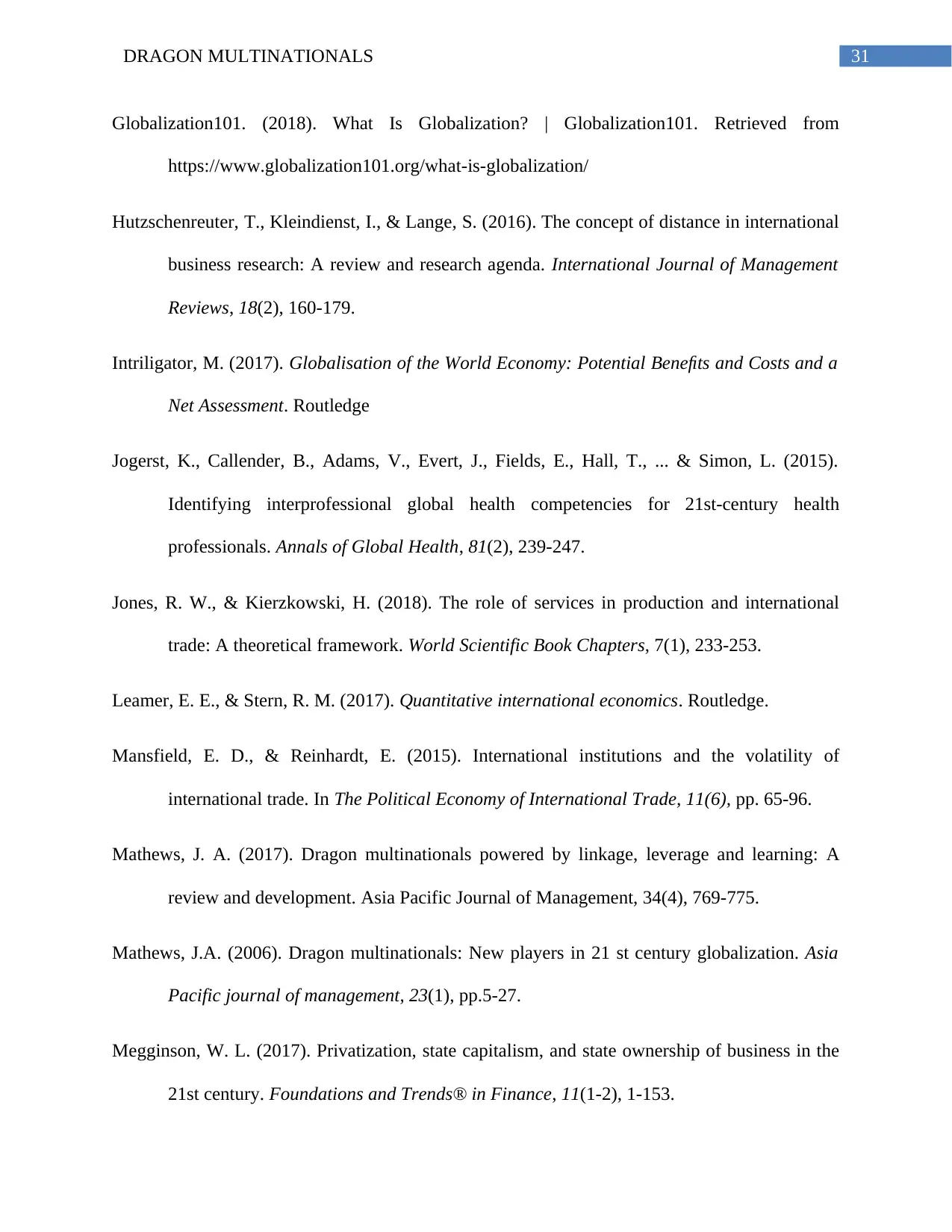
31DRAGON MULTINATIONALS
Globalization101. (2018). What Is Globalization? | Globalization101. Retrieved from
https://www.globalization101.org/what-is-globalization/
Hutzschenreuter, T., Kleindienst, I., & Lange, S. (2016). The concept of distance in international
business research: A review and research agenda. International Journal of Management
Reviews, 18(2), 160-179.
Intriligator, M. (2017). Globalisation of the World Economy: Potential Benefits and Costs and a
Net Assessment. Routledge
Jogerst, K., Callender, B., Adams, V., Evert, J., Fields, E., Hall, T., ... & Simon, L. (2015).
Identifying interprofessional global health competencies for 21st-century health
professionals. Annals of Global Health, 81(2), 239-247.
Jones, R. W., & Kierzkowski, H. (2018). The role of services in production and international
trade: A theoretical framework. World Scientific Book Chapters, 7(1), 233-253.
Leamer, E. E., & Stern, R. M. (2017). Quantitative international economics. Routledge.
Mansfield, E. D., & Reinhardt, E. (2015). International institutions and the volatility of
international trade. In The Political Economy of International Trade, 11(6), pp. 65-96.
Mathews, J. A. (2017). Dragon multinationals powered by linkage, leverage and learning: A
review and development. Asia Pacific Journal of Management, 34(4), 769-775.
Mathews, J.A. (2006). Dragon multinationals: New players in 21 st century globalization. Asia
Pacific journal of management, 23(1), pp.5-27.
Megginson, W. L. (2017). Privatization, state capitalism, and state ownership of business in the
21st century. Foundations and Trends® in Finance, 11(1-2), 1-153.
Globalization101. (2018). What Is Globalization? | Globalization101. Retrieved from
https://www.globalization101.org/what-is-globalization/
Hutzschenreuter, T., Kleindienst, I., & Lange, S. (2016). The concept of distance in international
business research: A review and research agenda. International Journal of Management
Reviews, 18(2), 160-179.
Intriligator, M. (2017). Globalisation of the World Economy: Potential Benefits and Costs and a
Net Assessment. Routledge
Jogerst, K., Callender, B., Adams, V., Evert, J., Fields, E., Hall, T., ... & Simon, L. (2015).
Identifying interprofessional global health competencies for 21st-century health
professionals. Annals of Global Health, 81(2), 239-247.
Jones, R. W., & Kierzkowski, H. (2018). The role of services in production and international
trade: A theoretical framework. World Scientific Book Chapters, 7(1), 233-253.
Leamer, E. E., & Stern, R. M. (2017). Quantitative international economics. Routledge.
Mansfield, E. D., & Reinhardt, E. (2015). International institutions and the volatility of
international trade. In The Political Economy of International Trade, 11(6), pp. 65-96.
Mathews, J. A. (2017). Dragon multinationals powered by linkage, leverage and learning: A
review and development. Asia Pacific Journal of Management, 34(4), 769-775.
Mathews, J.A. (2006). Dragon multinationals: New players in 21 st century globalization. Asia
Pacific journal of management, 23(1), pp.5-27.
Megginson, W. L. (2017). Privatization, state capitalism, and state ownership of business in the
21st century. Foundations and Trends® in Finance, 11(1-2), 1-153.
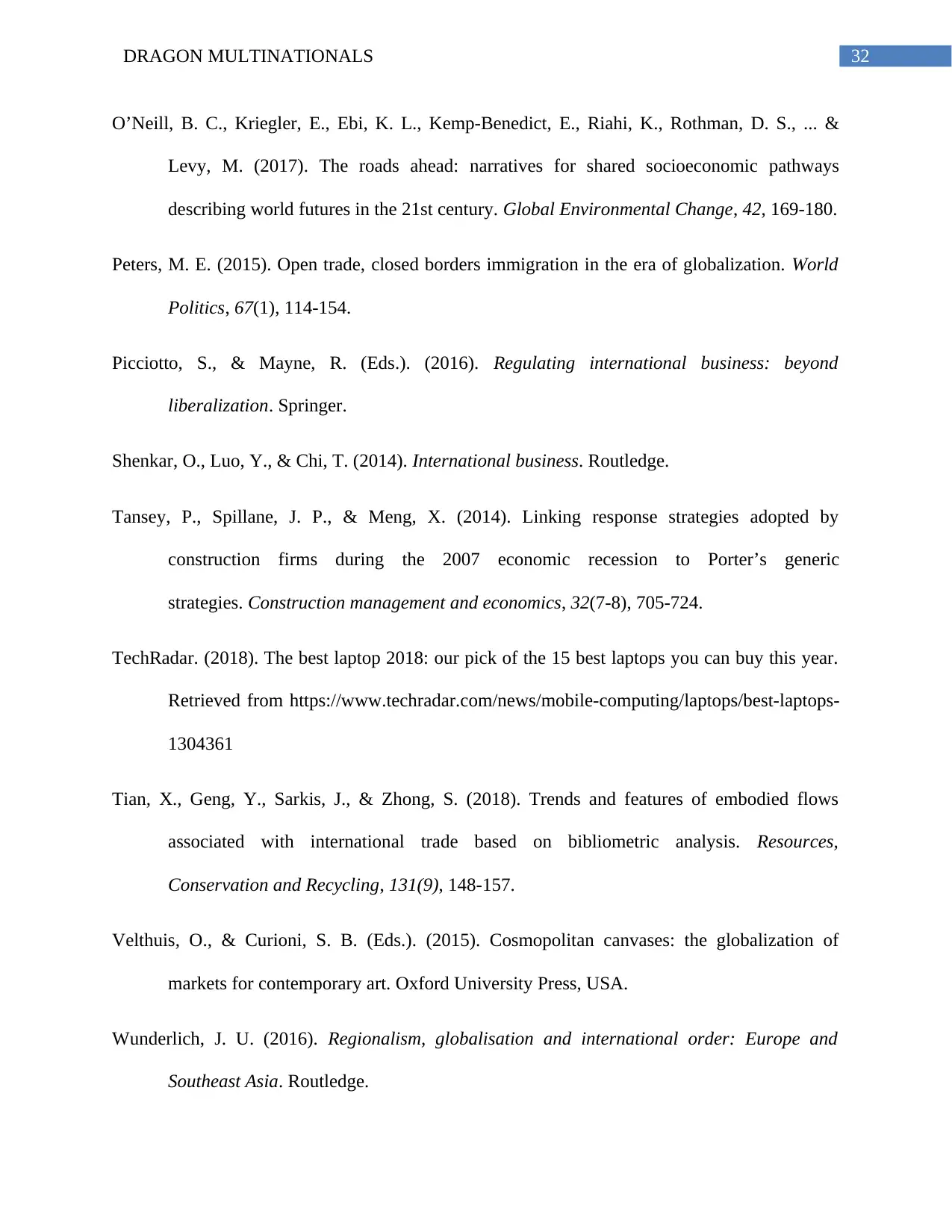
32DRAGON MULTINATIONALS
O’Neill, B. C., Kriegler, E., Ebi, K. L., Kemp-Benedict, E., Riahi, K., Rothman, D. S., ... &
Levy, M. (2017). The roads ahead: narratives for shared socioeconomic pathways
describing world futures in the 21st century. Global Environmental Change, 42, 169-180.
Peters, M. E. (2015). Open trade, closed borders immigration in the era of globalization. World
Politics, 67(1), 114-154.
Picciotto, S., & Mayne, R. (Eds.). (2016). Regulating international business: beyond
liberalization. Springer.
Shenkar, O., Luo, Y., & Chi, T. (2014). International business. Routledge.
Tansey, P., Spillane, J. P., & Meng, X. (2014). Linking response strategies adopted by
construction firms during the 2007 economic recession to Porter’s generic
strategies. Construction management and economics, 32(7-8), 705-724.
TechRadar. (2018). The best laptop 2018: our pick of the 15 best laptops you can buy this year.
Retrieved from https://www.techradar.com/news/mobile-computing/laptops/best-laptops-
1304361
Tian, X., Geng, Y., Sarkis, J., & Zhong, S. (2018). Trends and features of embodied flows
associated with international trade based on bibliometric analysis. Resources,
Conservation and Recycling, 131(9), 148-157.
Velthuis, O., & Curioni, S. B. (Eds.). (2015). Cosmopolitan canvases: the globalization of
markets for contemporary art. Oxford University Press, USA.
Wunderlich, J. U. (2016). Regionalism, globalisation and international order: Europe and
Southeast Asia. Routledge.
O’Neill, B. C., Kriegler, E., Ebi, K. L., Kemp-Benedict, E., Riahi, K., Rothman, D. S., ... &
Levy, M. (2017). The roads ahead: narratives for shared socioeconomic pathways
describing world futures in the 21st century. Global Environmental Change, 42, 169-180.
Peters, M. E. (2015). Open trade, closed borders immigration in the era of globalization. World
Politics, 67(1), 114-154.
Picciotto, S., & Mayne, R. (Eds.). (2016). Regulating international business: beyond
liberalization. Springer.
Shenkar, O., Luo, Y., & Chi, T. (2014). International business. Routledge.
Tansey, P., Spillane, J. P., & Meng, X. (2014). Linking response strategies adopted by
construction firms during the 2007 economic recession to Porter’s generic
strategies. Construction management and economics, 32(7-8), 705-724.
TechRadar. (2018). The best laptop 2018: our pick of the 15 best laptops you can buy this year.
Retrieved from https://www.techradar.com/news/mobile-computing/laptops/best-laptops-
1304361
Tian, X., Geng, Y., Sarkis, J., & Zhong, S. (2018). Trends and features of embodied flows
associated with international trade based on bibliometric analysis. Resources,
Conservation and Recycling, 131(9), 148-157.
Velthuis, O., & Curioni, S. B. (Eds.). (2015). Cosmopolitan canvases: the globalization of
markets for contemporary art. Oxford University Press, USA.
Wunderlich, J. U. (2016). Regionalism, globalisation and international order: Europe and
Southeast Asia. Routledge.
1 out of 33
Related Documents
Your All-in-One AI-Powered Toolkit for Academic Success.
+13062052269
info@desklib.com
Available 24*7 on WhatsApp / Email
![[object Object]](/_next/static/media/star-bottom.7253800d.svg)
Unlock your academic potential
© 2024 | Zucol Services PVT LTD | All rights reserved.





